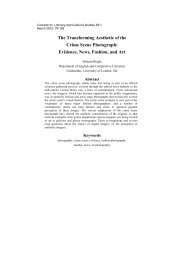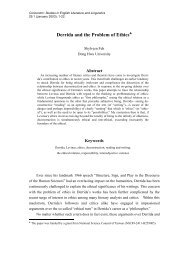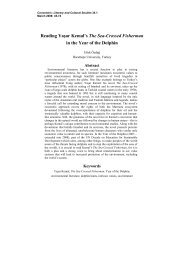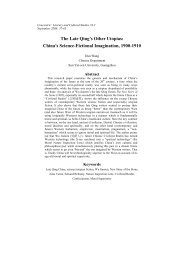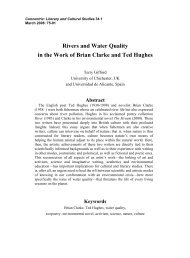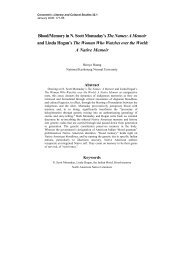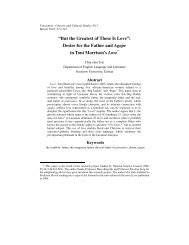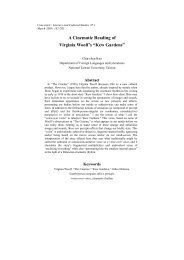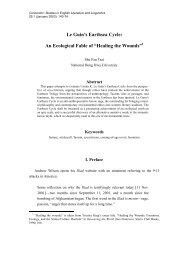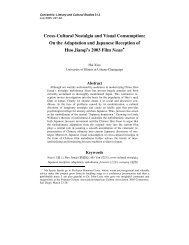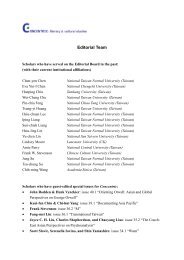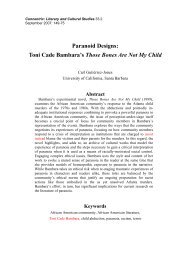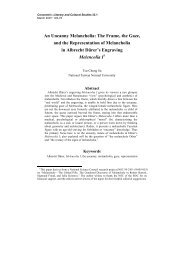Hybridization as the Postcolonial Anti-Exotic in Larissa ... - Concentric
Hybridization as the Postcolonial Anti-Exotic in Larissa ... - Concentric
Hybridization as the Postcolonial Anti-Exotic in Larissa ... - Concentric
Create successful ePaper yourself
Turn your PDF publications into a flip-book with our unique Google optimized e-Paper software.
<strong>Concentric</strong>: Literary and Cultural Studies 35.2Sept. 2009: 309-336<strong>Hybridization</strong> <strong>as</strong> <strong>the</strong> <strong>Postcolonial</strong> <strong>Anti</strong>-<strong>Exotic</strong> <strong>in</strong><strong>Larissa</strong> Lai’s Salt Fish Girl 1Kate Chiwen LiuDepartment of English Language and LiteratureFu Jen Catholic University, TaiwanAbstract<strong>Larissa</strong> Lai’s Salt Fish Girl resists <strong>the</strong> conta<strong>in</strong>ment strategies of Canadianmulticulturalism by us<strong>in</strong>g hybridity both <strong>the</strong>matically and <strong>as</strong> a textual strategy.Thematically, <strong>the</strong> characters’ hybridity <strong>in</strong> SFG, result<strong>in</strong>g from genetic clon<strong>in</strong>g,immigration and cultural commodification, reveals <strong>the</strong> power structures oftraditional Ch<strong>in</strong>a and a future North America, challenges <strong>the</strong> illusive stabilityof “home” and identity <strong>in</strong> both societies, and constructs a lesbian genealogyfrom <strong>the</strong> p<strong>as</strong>t to <strong>the</strong> future. Hybridity is also <strong>the</strong> text’s strategy ofcontextualiz<strong>in</strong>g and de-exoticiz<strong>in</strong>g its lesbian genealogy. The constructedlesbian genealogy is hybridized not only with <strong>the</strong> characters’ geneticallymixed bodies and identities embody<strong>in</strong>g multiple positions, but also through<strong>the</strong> text’s plural beg<strong>in</strong>n<strong>in</strong>gs, end<strong>in</strong>gs, l<strong>in</strong>es of development <strong>as</strong> well <strong>as</strong> multiple<strong>in</strong>tertexts. Besides pluraliz<strong>in</strong>g <strong>the</strong> mean<strong>in</strong>gs of “home,” fur<strong>the</strong>rmore, <strong>the</strong> texthybridizes and contextualizes a variety of elements traditionally <strong>as</strong>sociatedwith <strong>the</strong> “Oriental”: <strong>the</strong> mythic goddess Nu Wa, New Kubla Khan, <strong>the</strong> opiumden, ethnic foods (durian and salt fish) and exotic ornaments. Such a hybridgenealogy is thus contextualized because all <strong>the</strong> time-spaces <strong>the</strong> charactersexperience take on multiple social mean<strong>in</strong>gs perta<strong>in</strong><strong>in</strong>g to <strong>the</strong> exploitation andexoticization of Asian di<strong>as</strong>pora <strong>in</strong> <strong>the</strong> age of mult<strong>in</strong>ational capitalism. SaltFish Girl’s strategies of hybridization, <strong>the</strong>n, are <strong>the</strong> “post-colonial anti-exotic”strategies that “re-politicize” <strong>the</strong> “exotic” elements to evade <strong>the</strong> Orientalistgaze supported by both capitalism and Canada’s official multiculturalism, andto empower its characters <strong>in</strong> <strong>the</strong>ir multi-layered social networks. At <strong>the</strong> end,however, <strong>the</strong> text <strong>as</strong>ks, with its two open end<strong>in</strong>gs, a difficult question of howdifferences can be recognized and what recognition means.Keywordshybridity, <strong>Larissa</strong> Lai, Sal t Fish Girl, <strong>the</strong> post-colonial anti-exotic1 My heartfelt appreciation goes to <strong>Larissa</strong> Lai, for her illum<strong>in</strong>at<strong>in</strong>g answers to <strong>the</strong> questionsraised by me and my students, and to Guy Beauregard and <strong>the</strong> two anonymous reviewers for <strong>the</strong>ir<strong>in</strong>cisive critique of my paper at <strong>the</strong> different stages of its revision.
310 <strong>Concentric</strong> 35.2 (Sept. 2009): 309-336I. Official Multiculturalism vs. <strong>the</strong> “<strong>Postcolonial</strong> <strong>Anti</strong>-<strong>Exotic</strong>”S<strong>in</strong>ce its <strong>in</strong>ception <strong>in</strong> 1971, Canadian multiculturalism h<strong>as</strong> long been an objectof debate and contestation, 2 <strong>in</strong> response to which its focus h<strong>as</strong> shifted fromcelebrat<strong>in</strong>g ethnic differences <strong>in</strong> <strong>the</strong> 70’s, manag<strong>in</strong>g diversity <strong>in</strong>stitutionally <strong>in</strong> <strong>the</strong>80’s, to ensur<strong>in</strong>g equal rights and civic participation s<strong>in</strong>ce <strong>the</strong> 90’s (Fler<strong>as</strong> 11-17).Although its ideal of equity, especially <strong>in</strong> terms of equal access to social resourcessuch <strong>as</strong> education, hous<strong>in</strong>g and work opportunities, is far from be<strong>in</strong>g realized,defenders of Canadian multiculturalism believe that <strong>in</strong> Canada “plural is possible”(Adam Gopnik <strong>in</strong> “Adam Gopnik vs. Malcolm Gladwell”), and that its society is“<strong>the</strong> most successful pluralist [one] on <strong>the</strong> face of our globe” (“Canada: 'A modelfor <strong>the</strong> world'”). On <strong>the</strong> o<strong>the</strong>r hand, <strong>as</strong> Fler<strong>as</strong> po<strong>in</strong>ts out, official multiculturalism is“essentially a society-build<strong>in</strong>g exercise that seeks to de-politicize differencesthrough <strong>in</strong>stitutional accommodation” (20). In o<strong>the</strong>r words, <strong>the</strong>re have beenattempts at try<strong>in</strong>g to conta<strong>in</strong> or reduce cultural diversities, so that Canadian societycan be “safe from diversity, safe for diversity” (21). For <strong>in</strong>stance, a survey carriedout by Innovative Research Group <strong>in</strong> 2005 shows that 70% of <strong>the</strong> Canadianrespondents th<strong>in</strong>k that adapt<strong>in</strong>g to “<strong>the</strong> Canadian way of life” should be <strong>the</strong> priorityfor new immigrants (“Multicultural Canada <strong>in</strong> <strong>the</strong> 21 st Century”). Ano<strong>the</strong>r exampleis <strong>the</strong> violent reaction aga<strong>in</strong>st UBC professor Sunera Thobani after her speechaga<strong>in</strong>st US imperialism <strong>in</strong> October, 2001. At <strong>the</strong> time when <strong>the</strong>re is “a re-whiten<strong>in</strong>gof Canadian identity and <strong>in</strong>cre<strong>as</strong>ed marg<strong>in</strong>alization of its nonwhite m<strong>in</strong>orities” (32),Thobani received harsh criticism and even personal attacks because, accord<strong>in</strong>g toArat-Koc, she spoke <strong>as</strong> a “modern subject” but not <strong>as</strong> an “ethnic m<strong>in</strong>ority” <strong>in</strong> anOrientalized position <strong>as</strong>signed to her (46).The apparent “tolerance” shown toward cultural diversity <strong>in</strong> <strong>the</strong> multiculturalCanada can be seen a strategy of conta<strong>in</strong>ment, hid<strong>in</strong>g <strong>the</strong> nation’s externalboundaries and <strong>in</strong>ternal hierarchies, both of which become more discrim<strong>in</strong>atory tovisible m<strong>in</strong>orities at times of crisis, change and conflicts of <strong>in</strong>terests. In <strong>the</strong> field ofliterary production, such efforts at conta<strong>in</strong>ment can be perceived <strong>in</strong> <strong>the</strong> selectiveacceptance of works by writers of visible m<strong>in</strong>orities, usually categorized <strong>as</strong>“immigrant writ<strong>in</strong>gs.” As Christ<strong>in</strong>e Kim po<strong>in</strong>ts out, <strong>Larissa</strong> Lai’s first novel, When2 See, for <strong>in</strong>stance, Fernando’s summary of <strong>the</strong> debate, which became more heated because oftwo books, <strong>in</strong> particular: Neil Bissoondath's Sell<strong>in</strong>g Illusions: The Cult of Multiculturalism <strong>in</strong>Canada (1994), and Richard Gwyn's Nationalism Without Walls: The Unbearable Lightness ofBe<strong>in</strong>g Canadian (1995) 28-31. Huang also gives a detailed <strong>in</strong>troduction to CanadianMulticulturalism, its history, myth, <strong>as</strong> well <strong>as</strong> <strong>the</strong> critiques and reconstructions it receives, 1-30.
Liu / <strong>Hybridization</strong> <strong>as</strong> <strong>the</strong> <strong>Postcolonial</strong> <strong>Anti</strong>-<strong>Exotic</strong> 311Fox is a Thousand, h<strong>as</strong> not received <strong>the</strong> same levels of critical and commercialsuccess <strong>as</strong> Shani Mootoo’s Cereus Blooms at Night, partly because <strong>the</strong> former—critiqu<strong>in</strong>g dom<strong>in</strong>ant representations of Asian Canadians with<strong>in</strong> <strong>the</strong> nation anddisrupt<strong>in</strong>g discourses of Canadian multiculturalism, <strong>as</strong> it does—is not <strong>as</strong> “e<strong>as</strong>ilyexoticized” <strong>as</strong> <strong>the</strong> latter (154, 168). Kim thus argues that <strong>the</strong>re is a need to designnew strategies to read this body of literary works so <strong>as</strong> to re-shape market trendsand reader expectations.Lai herself, <strong>as</strong> a matter of fact, is not unaware of this need to carve out a space<strong>in</strong> and beyond contemporary Canadian literary canon. As can be seen from <strong>the</strong>many essays she h<strong>as</strong> written, she positions herself aga<strong>in</strong>st <strong>the</strong> conta<strong>in</strong>ment strategiesof official multiculturalism, whose b<strong>in</strong>arist logic even <strong>the</strong> identity politicsmovement 3 with which she w<strong>as</strong> <strong>in</strong>volved failed to evade. She po<strong>in</strong>ts out that <strong>the</strong>multiculturalism of <strong>the</strong> Trudeau era w<strong>as</strong> quite limited <strong>in</strong> terms of who or what w<strong>as</strong>accepted: “only those k<strong>in</strong>ds of safe difference that could be perceived <strong>as</strong>commensurate with perceived ‘Canadian’ traits’ could enter sanctioned discourse”(“Corrupted L<strong>in</strong>eage” 43-44). In response, <strong>the</strong> identity politics movement refused toplay by <strong>the</strong>se multiculturalist rules, and focused on “construct<strong>in</strong>g empoweredidentities” for visible m<strong>in</strong>orities (“Forward” 16; “Future Asians” 168). However,one problem with <strong>the</strong> identity politics movement, among o<strong>the</strong>rs, w<strong>as</strong> that <strong>in</strong><strong>as</strong>sert<strong>in</strong>g one’s difference from <strong>the</strong> ma<strong>in</strong>stream one re<strong>in</strong>forces <strong>the</strong> Self-O<strong>the</strong>rb<strong>in</strong>arism (“Political Animals” 149; “Corrupted L<strong>in</strong>eage” 44). For <strong>in</strong>stance, <strong>the</strong>m<strong>in</strong>ority writers of that generation tried to break through <strong>the</strong> barriers of silence andarticulate <strong>the</strong> repressed history to <strong>the</strong> full. With all <strong>the</strong>ir critical <strong>in</strong>tent, <strong>the</strong> historiesarticulated had to be subject to <strong>the</strong> selection logic of <strong>the</strong> publish<strong>in</strong>g bus<strong>in</strong>ess andthose “favored” ones fed <strong>in</strong>to <strong>the</strong> exoticist imag<strong>in</strong>ation of <strong>the</strong> read<strong>in</strong>g public and<strong>the</strong>ir <strong>as</strong>sumptions about a terrible O<strong>the</strong>r/p<strong>as</strong>t or a liberated Self/present. 4 In writ<strong>in</strong>gher novels, <strong>the</strong>refore, Lai herself is quite wary of be<strong>in</strong>g trapped <strong>in</strong> this “racializedspace” of literary production and reception, which can be both empower<strong>in</strong>g andpigeonhol<strong>in</strong>g.3 The identity politics movement w<strong>as</strong> marked by a series of important events from late 1980sto early 1990s: <strong>the</strong> <strong>in</strong>ternational film and video conference/symposium In Visible Colours (1989),<strong>the</strong> film and video conference/workshop About Face, About Frame (1992), <strong>the</strong> 1993 conferenceIt's a Cultural Th<strong>in</strong>g and <strong>the</strong> very controversial national writers' conference <strong>in</strong> 1994, Writ<strong>in</strong>g ThruRace (See Gagnon).4 Lai po<strong>in</strong>ts out, for <strong>in</strong>stance, <strong>the</strong>re is <strong>in</strong> Canadian publish<strong>in</strong>g <strong>in</strong>dustry a preference fornarratives of “p<strong>as</strong>t <strong>in</strong>justice . . . or brutal histories of ‘over <strong>the</strong>re’” (“Corrupted L<strong>in</strong>eage” 42). Theexamples she gives of <strong>the</strong> preferred ones are Disappear<strong>in</strong>g Moon Café and The Jade Peony.
312 <strong>Concentric</strong> 35.2 (Sept. 2009): 309-336The dilemma Lai describes can be related to what Huggan calls “<strong>the</strong>postcolonial exotic” <strong>in</strong> <strong>the</strong> global and Canadian markets. Huggan uses <strong>the</strong> term “<strong>the</strong>postcolonial exotic” to mark <strong>the</strong> <strong>in</strong>tersection of two regimes of values:postcolonialism, with its anti-colonial efforts, and postcoloniality, or <strong>the</strong>socio-economic conditions of today’s postcolonial world and its global market (28).The <strong>in</strong>tersection happens because <strong>in</strong>evitably any postcolonial texts have to enter <strong>the</strong>market and be subject to its logic of selection, market<strong>in</strong>g, and, possibly, itsexoticism: that is, posit<strong>in</strong>g visible m<strong>in</strong>orities <strong>as</strong> cultural strangers, or us<strong>in</strong>g <strong>the</strong>“rhetoric of fetishized o<strong>the</strong>rness and sympa<strong>the</strong>tic identification” to m<strong>as</strong>k <strong>the</strong><strong>in</strong>equality of <strong>the</strong> power relations without which <strong>the</strong> discourse [of self-empower<strong>in</strong>g]could not function” (Huggan 13). Some postcolonial cultural texts such <strong>as</strong> SalmanRushdie’s Midnight’s Children, Arundhati Roy’s The God of Small Th<strong>in</strong>gs and AtomEgoyan’s <strong>Exotic</strong>a, accord<strong>in</strong>g to Huggan, use exoticism strategically or specularizemarg<strong>in</strong>ality to critique Orientalism only to partake of it <strong>in</strong>advertently: <strong>the</strong>se textsflaunt mythic, romantic-nostalgic or erotic images of exoticism “derid<strong>in</strong>gly” at <strong>the</strong>irreaders/spectators to <strong>the</strong> effect of “[trapp<strong>in</strong>g] <strong>the</strong> unwary reader <strong>in</strong>to complicitywith <strong>the</strong> Orientalisms of which <strong>the</strong> novel[s] so haunt<strong>in</strong>gly [relate]” (77, 153).While I disagree with Huggan’s generalization about <strong>the</strong> “West,” hisconflation of a book’s market values and its mean<strong>in</strong>gs, and his quick read<strong>in</strong>gs ofsome of <strong>the</strong> postcolonial texts mentioned above 5 , he does po<strong>in</strong>t to <strong>the</strong> f<strong>in</strong>e l<strong>in</strong>esbetween commodification/consumption and Orientalist gaze on one side, andtranscultural understand<strong>in</strong>g on <strong>the</strong> o<strong>the</strong>r, <strong>in</strong> an era when postcolonialism andpostcoloniality are overlapp<strong>in</strong>g and everyth<strong>in</strong>g is commodified. Besides <strong>the</strong>examples Huggan and Lai give of those <strong>in</strong> <strong>the</strong> favor of <strong>the</strong> publish<strong>in</strong>g bus<strong>in</strong>ess andread<strong>in</strong>g public with <strong>the</strong> mythic, erotic or historical, Goellnicht and Kim also po<strong>in</strong>tout that South Asian Canadian novels by Mistry, Selvadurai and Mootoo arepopular partly because <strong>the</strong>y describe racism happen<strong>in</strong>g <strong>in</strong> distant places but not <strong>in</strong>Canada (Kim 163). Although I don’t th<strong>in</strong>k that a postcolonial text’s popularitybespeaks its complicity with <strong>the</strong> capitalist logic of consumption and reification, <strong>the</strong>whole process of distribution, market<strong>in</strong>g and canon formation can lead to reificationand objectification of <strong>the</strong> “o<strong>the</strong>rs.” In such a multi-mediated network ofcommunication and circulation, how does a postcolonial writer/reader construct <strong>the</strong>marg<strong>in</strong>alized without fix<strong>in</strong>g <strong>the</strong>m <strong>as</strong> objects of gaze? How does a text construct a5 For <strong>in</strong>stance, he argues that <strong>Exotic</strong>a “oscillates between <strong>the</strong> alternative poles of surreptitioussocial control and profoundly anti-social concealment,” ignor<strong>in</strong>g <strong>the</strong> structure of community andsympathy established among <strong>the</strong> film’s marg<strong>in</strong>alized characters, which is nei<strong>the</strong>r anti-social nor aform of concealment (151).
Liu / <strong>Hybridization</strong> <strong>as</strong> <strong>the</strong> <strong>Postcolonial</strong> <strong>Anti</strong>-<strong>Exotic</strong> 313“contact zone” (Susan Friedman 90) which supports multi-directional culturaltranslations and <strong>in</strong>teractions but not simplification of <strong>the</strong> o<strong>the</strong>rs—ei<strong>the</strong>r <strong>as</strong> “<strong>the</strong>strange” or “<strong>the</strong> familiar”—for “self”-empowerment and enterta<strong>in</strong>ment?Although a text’s mean<strong>in</strong>g is produced out of some complicated processes ofencod<strong>in</strong>g and de-cod<strong>in</strong>g, Lai’s work does attempt to avoid “[empower<strong>in</strong>g] <strong>the</strong>media mach<strong>in</strong>e to replicate <strong>the</strong> same trope” or fix <strong>the</strong> di<strong>as</strong>poric identities(“Corrupted L<strong>in</strong>eage” 44). Accord<strong>in</strong>g to Lai, to avoid <strong>the</strong> ei<strong>the</strong>r-or trap ofracialization, she h<strong>as</strong> tried <strong>in</strong> her work to “[construct] a consciously artificialhistory” (“Political Animals” 149). In her “artificial” history <strong>the</strong> “always alreadycoded” elements of di<strong>as</strong>poric Ch<strong>in</strong>ese culture should, I believe, be seen <strong>as</strong> be<strong>in</strong>ghybridized and (<strong>in</strong>ter-)textualized so that <strong>the</strong>ir histories are more spatialized andnetworked, than l<strong>in</strong>ear and teleological. More specifically, if some postcolonialwriters’ strategic use of exoticism and marg<strong>in</strong>ality can be co-opted because, forreaders, <strong>the</strong>y rema<strong>in</strong> “exotic”—strangely familiar and allur<strong>in</strong>g objects offetishization and decontextualization—Lai’s Salt Fish Girl, I want to argue, adoptstwo strategies to avoid fix<strong>in</strong>g its characters’ identities and re-<strong>in</strong>scrib<strong>in</strong>g <strong>the</strong>m <strong>in</strong>to<strong>the</strong> logic of exoticization: first us<strong>in</strong>g a revisionary and hybridiz<strong>in</strong>g mode ofnarrat<strong>in</strong>g a creation myth to develop a non-l<strong>in</strong>ear lesbian genealogy, and <strong>the</strong>n ahybridiz<strong>in</strong>g treatment of images and spaces to form a network of social issuesrelated to Ch<strong>in</strong>ese di<strong>as</strong>pora, p<strong>as</strong>t and present.Many critics have noted <strong>in</strong> Lai’s novels <strong>the</strong> border-cross<strong>in</strong>g and hybridiz<strong>in</strong>gimpulses on <strong>the</strong> levels of subjectivity and genre, <strong>as</strong> well <strong>as</strong> <strong>the</strong>ir resonances withtoday’s world. Both Fu and Morris analyze <strong>the</strong> heterogeneity and transformations of<strong>the</strong> characters <strong>in</strong> When Fox is a Thousand (hereafter cited <strong>as</strong> Fox). Fu po<strong>in</strong>ts outthat Fox “(trans)forms, (trans)poses, and (trans)genders her subjects and offers anarray of cross-cultural, -racial, -sexual, -gender identifications,” which “straddledifferent spheres and disrupt <strong>the</strong> sense of reality and complacency of those worlds”(157, 163). Morris analyzes how Fox uses both hybrid characters and “generic<strong>in</strong>terweav<strong>in</strong>g”(71, 72) to defy categorization and question <strong>the</strong> predom<strong>in</strong>antly whitemale gaze and control <strong>as</strong> represented by Blade Runner. In <strong>the</strong>ir analyses of Salt FishGirl (hereafter cited <strong>as</strong> SFG), Cuder-Domínguez analyzes its creative revision ofspeculative fiction to enable multiple constructions of Asian women’s subjectivity,while both Wong and Mansbridge see <strong>the</strong> hybrid characters <strong>as</strong> “<strong>the</strong> abject,” and<strong>the</strong>ir spaces and histories <strong>as</strong> <strong>the</strong> “unheimlich,” that subvert <strong>the</strong> homely space ofCanada. For Cuder-Domínguez, SFG envisions a “hopeful” future on <strong>the</strong> characters’personal level (127), where<strong>as</strong> Wong and Mansbridge see <strong>the</strong> novel more <strong>as</strong> acritique of contemporary Canada, its exploitation of Ch<strong>in</strong>ese garment workers
314 <strong>Concentric</strong> 35.2 (Sept. 2009): 309-336(Wong), or <strong>the</strong> notion of Canada <strong>as</strong> “a homely nation” (Mansbridge 121). Tara Lee,besides analyz<strong>in</strong>g <strong>the</strong> text’s critique of <strong>the</strong> complicity between science andcapitalism, uses <strong>the</strong> trope of cyborg on <strong>the</strong> hybrid identities and sees <strong>in</strong> <strong>the</strong>m <strong>the</strong>political possibility of creat<strong>in</strong>g new forms by “read<strong>in</strong>g and re-read<strong>in</strong>g <strong>the</strong> mixedorig<strong>in</strong> which is <strong>in</strong> <strong>the</strong>ir makeup” (214; emph<strong>as</strong>is added).To add to <strong>the</strong>se critics’ analyses of <strong>the</strong> hybrid characters and genres <strong>in</strong> Lai’snovels, I will discuss hybridity <strong>as</strong> a process of hybridiz<strong>in</strong>g network<strong>in</strong>g <strong>in</strong> SFG. Forme, SFG constructs a lesbian genealogy by not only revis<strong>in</strong>g and hybridiz<strong>in</strong>gtraditional creation myths, but also pluraliz<strong>in</strong>g and “spatializ<strong>in</strong>g” its plotl<strong>in</strong>es so thatits “orig<strong>in</strong>” and “memory” are mutually constructive. Also, SFG’s hybridization<strong>in</strong>volves connect<strong>in</strong>g <strong>the</strong> “Ch<strong>in</strong>ese/Asian Canadian” spaces and signs <strong>in</strong> its textualnetwork so that <strong>the</strong>y present both <strong>the</strong> problems and utopian possibilities of lesbianand di<strong>as</strong>poric hybrid identities while evad<strong>in</strong>g <strong>the</strong> fetishiz<strong>in</strong>g Orientalist gazesupported by both capitalism and Canada’s official multiculturalism. In whatfollows, I will first expla<strong>in</strong> my usage of <strong>the</strong> concept of hybridity <strong>in</strong> relation to <strong>the</strong>debates around it, and <strong>the</strong>n del<strong>in</strong>eate <strong>the</strong> textualized lesbian genealogy constructed<strong>in</strong> SFG, which is fur<strong>the</strong>r hybridized by its use of “Ch<strong>in</strong>ese” signs and spaces.II. Hybridity <strong>in</strong> DebateS<strong>in</strong>ce its emergence <strong>in</strong> <strong>the</strong> n<strong>in</strong>eteenth century, hybridity, or <strong>the</strong> forc<strong>in</strong>g to growtoge<strong>the</strong>r of two dist<strong>in</strong>ct be<strong>in</strong>gs or cultural matters 6 , h<strong>as</strong> been <strong>in</strong>terest<strong>in</strong>glyproblematic <strong>as</strong> an analytic tool. Usually categorized <strong>in</strong>to l<strong>in</strong>guistic-cultural andgenetic-racial hybridity, hybridity h<strong>as</strong> been an issue for debate, <strong>as</strong> <strong>the</strong> concept is6 Def<strong>in</strong>ed biologically, hybridity means “disruption and forc<strong>in</strong>g toge<strong>the</strong>r of any liv<strong>in</strong>g th<strong>in</strong>gs”(Young 26). Def<strong>in</strong>ed culturally, it means “<strong>the</strong> fusion of two hi<strong>the</strong>rto relatively dist<strong>in</strong>ct forms,styles or identities, cross-cultural contact” (Kraidy 5). The anthropologist Brian Stross provides acomprehensive def<strong>in</strong>ition of <strong>the</strong> term which <strong>in</strong>cludes its orig<strong>in</strong>al mean<strong>in</strong>g and later extensions: “InLat<strong>in</strong> <strong>the</strong> hibrida w<strong>as</strong> <strong>the</strong> offpr<strong>in</strong>g of a (female) domestic sow and a (male) wild boar. Thesemantic range of <strong>the</strong> word hybrid h<strong>as</strong> expanded <strong>in</strong> more recent times to <strong>in</strong>clude <strong>the</strong> offspr<strong>in</strong>g of amat<strong>in</strong>g by any two unlike animals or plants. The cultural hybrid is a metaphorical broaden<strong>in</strong>g ofthis biological def<strong>in</strong>ition. It can be a person who represents <strong>the</strong> blend<strong>in</strong>g of traits from diversecultures or traditions, or even more broadly it can be a culture, or element of culture, derived fromunlike sources; that is, someth<strong>in</strong>g heterogeneous <strong>in</strong> orig<strong>in</strong> or composition” (254 emph<strong>as</strong>is added).Def<strong>in</strong>ition of hybridity h<strong>as</strong> been modified and extended differently <strong>in</strong> different fields. For <strong>in</strong>stance,Young po<strong>in</strong>ts out that hybridization can beg<strong>in</strong> with “forc<strong>in</strong>g of a s<strong>in</strong>gle entity <strong>in</strong>to two or moreparts,” <strong>as</strong> <strong>in</strong> <strong>the</strong> operation of hybrid shares on <strong>the</strong> stock market (26). The “mix<strong>in</strong>g” <strong>in</strong> hybriditycan be fur<strong>the</strong>r differentiated <strong>in</strong>to “fusion of differences” on <strong>the</strong> one hand, mixture of someth<strong>in</strong>galready syncretic on <strong>the</strong> o<strong>the</strong>r, with different degrees of rema<strong>in</strong><strong>in</strong>g dist<strong>in</strong>ctness <strong>in</strong> between (SusanFriedman 85).
Liu / <strong>Hybridization</strong> <strong>as</strong> <strong>the</strong> <strong>Postcolonial</strong> <strong>Anti</strong>-<strong>Exotic</strong> 315<strong>as</strong>sociated biologically with miscegenation, cross-fertilization and hybrid vigor <strong>in</strong>genetics, horticulture and biotechnology, and, culturally, with contam<strong>in</strong>ation,mimicry and cultural diversity <strong>in</strong> anthropology, colonial and postcolonial discourses.The term “hybridity” is heavily loaded also because, besides be<strong>in</strong>g used differently<strong>in</strong> <strong>the</strong> fields rang<strong>in</strong>g from biotechnology to f<strong>as</strong>hion, from music, literature to <strong>the</strong>stock market and car <strong>in</strong>dustry, it is engaged <strong>in</strong> cultural discourses on <strong>in</strong>dividual andcollective levels <strong>as</strong> someth<strong>in</strong>g radical and transgressive, or <strong>as</strong> a matter of rout<strong>in</strong>eand everyday practices. <strong>Hybridization</strong>, likewise, <strong>in</strong>volves co-optation and<strong>as</strong>similation by <strong>the</strong> dom<strong>in</strong>ant cultures, <strong>in</strong>version and subversion of <strong>the</strong> lim<strong>in</strong>al,gradual creolization of languages, multiple border-cross<strong>in</strong>g of <strong>the</strong> di<strong>as</strong>poric,mimicry, bricolage, parody and (re-)mix<strong>in</strong>g-and-mediat<strong>in</strong>g of artistic styles, and,l<strong>as</strong>t but not <strong>the</strong> le<strong>as</strong>t, selection, modification and mixture of genes, foods, codes andstyles to produce commodities and construct identities on daily b<strong>as</strong>is. 7Though dissociated more from its negative implications such <strong>as</strong> impurity andfragmentation now than before, hybridity is still a target of criticism for two<strong>in</strong>terrelated re<strong>as</strong>ons: (1) that, <strong>as</strong> a conceptual tool, it is too ambiguous to be<strong>the</strong>oretically rigorous and (2) that, on <strong>the</strong> empirical level, it lacks “revolutionarypotential” (van der Veer 104). The use of hybridity can be ambiguous because, <strong>as</strong> adescriptive catchall term, it “fails to discrim<strong>in</strong>ate between <strong>the</strong> diverse modalities ofhybridity” (Stam 60). For <strong>the</strong> dissenters, <strong>the</strong> so-called “hybridity talk” is thus seen<strong>as</strong> “an ‘elite’ preoccupation” (Mukherjee 21) which “looks everywhere than <strong>the</strong>street” (Jonathan Friedman 75), where hybridity can be experienced pa<strong>in</strong>fully andwithout a choice by those <strong>in</strong> <strong>the</strong> lower rungs of <strong>the</strong> social ladder (<strong>the</strong> c<strong>as</strong>e ofmelam<strong>in</strong>e-ta<strong>in</strong>ted milk powder erupt<strong>in</strong>g <strong>in</strong> <strong>the</strong> Fall of 2008 is a c<strong>as</strong>e <strong>in</strong> po<strong>in</strong>t).Politically, confirmation of cultural diversity can lead to tokenism, vertical mosaic,or, <strong>in</strong> post-apar<strong>the</strong>id South Africa, it can “come dangerously close to reproduc<strong>in</strong>g<strong>the</strong> ideology of ‘separate development’ (Mathieson and Atwell qtd. <strong>in</strong> Brah andCoombes 2). In popular culture, moreover, cultural hybridity can be a sell<strong>in</strong>g po<strong>in</strong>t:<strong>as</strong> mixtures of exotic flavors <strong>in</strong> restaurant menus and f<strong>as</strong>hion styles, or those of7 There have been several succ<strong>in</strong>ct overviews of <strong>the</strong> development of hybridity discourses. I amespecially <strong>in</strong>debted to Robert Young for his connect<strong>in</strong>g cultural hybridity to its racial andbiological counterparts, and for his trac<strong>in</strong>g its history to <strong>the</strong> n<strong>in</strong>eteenth-century debates <strong>in</strong> geneticsand horticulture; to Susan Friedman, for her mapp<strong>in</strong>g of hybridity <strong>the</strong>ory <strong>in</strong> terms of <strong>the</strong> types ofcultural mix<strong>in</strong>g, its function, spatial and temporal orientation, <strong>as</strong> well <strong>as</strong> <strong>the</strong> power relations<strong>in</strong>volved; to Kapchan and Strong, for <strong>the</strong>ir connect<strong>in</strong>g <strong>the</strong> concept to <strong>the</strong> related concepts ofsyncretism, bricolage and creolization; to Laura Moss, for suggest<strong>in</strong>g a way to move beyond <strong>the</strong>two poles of hybridity discourses—contam<strong>in</strong>ation and celebration: see<strong>in</strong>g racial hybridity <strong>as</strong> an<strong>in</strong>cre<strong>as</strong><strong>in</strong>gly ord<strong>in</strong>ary state, and, fur<strong>the</strong>r, to Marwan Kraidy, for provid<strong>in</strong>g examples ofhybridization <strong>in</strong> journalism, m<strong>as</strong>s production and reception <strong>in</strong> global cultural exchanges.
316 <strong>Concentric</strong> 35.2 (Sept. 2009): 309-336ethnic “colors” <strong>in</strong> ads, <strong>in</strong>terior decoration and spectacular shows for visualconsumption. For Hutnyk, <strong>the</strong>refore, hybridity is a political void, because “thispolitical project seems too often to have given way to an analysis of textualconstruction”; because “hybridity and difference sell; <strong>the</strong> market rema<strong>in</strong>s <strong>in</strong>tact” (122).Despite and probably because of <strong>the</strong>ir ambivalence and complexity, <strong>the</strong>cultural phenomena of hybridity should cont<strong>in</strong>ue to be understood and <strong>in</strong>vestigatedby us today <strong>in</strong> this globaliz<strong>in</strong>g world; it is a matter of how to develop strategies ofpresent<strong>in</strong>g and read<strong>in</strong>g hybridity. Undeniably, hybridization, to borrow Kraidy’sterm, is a “cultural logic of globalization”(148) that is happen<strong>in</strong>g on daily b<strong>as</strong>is toalmost all <strong>the</strong> <strong>as</strong>pects of our lives—to such an extent that no food is not geneticallymodified 8 , no nation can be self-conta<strong>in</strong>ed, and nobody can be 100 percent naturallyand purely “human.” In this global world of <strong>in</strong>terconnectedness, it is a crucial wayof “self”-position<strong>in</strong>g to try to perceive and locate, negotiate and at times contest <strong>the</strong>multiple hybridiz<strong>in</strong>g forces <strong>in</strong>, on and around us, <strong>as</strong> well <strong>as</strong> to articulate <strong>the</strong>irdifferences and <strong>in</strong>terconnections.The cultural relevancy of hybridity alone, however, does not justify its usage<strong>as</strong> an analytical tool. Conceptually, <strong>in</strong> my view, hybridity stimulates analysis of <strong>the</strong>powers <strong>in</strong>volved <strong>in</strong> and between <strong>the</strong> “mixtures” of various types, and thus helpsmap <strong>the</strong>ir power relations. Instead of dismiss<strong>in</strong>g <strong>the</strong> literary or cultural hybridworks <strong>as</strong> less disruptive or non-revolutionary (e.g. Hutnyk and van der Veer), <strong>the</strong>studies of cultural hybridity should move beyond polariz<strong>in</strong>g dom<strong>in</strong>ation andtransgression/resistance, to exam<strong>in</strong>e <strong>the</strong> power structures <strong>in</strong>volved <strong>in</strong> and aroundeach <strong>in</strong>stance of hybridization. 9 Like Kraidy, I see hybridity <strong>as</strong> a discursiveformation, <strong>in</strong> which text and context are mutually constitutive, if not <strong>in</strong>separable. 10From a discursive perspective, both <strong>the</strong> hybrid “text” and its “context” are dynamic,multi-layered, and with manifold <strong>in</strong>teractions among its discipl<strong>in</strong>ary, historical andempirical levels, just <strong>as</strong> <strong>the</strong> driv<strong>in</strong>g forces of hybridity—be <strong>the</strong>y genetic8 Just <strong>as</strong> cultural critics argue that cultures have always been hybrid, accord<strong>in</strong>g to SusanMcCouch, genetic modification h<strong>as</strong> been done all <strong>the</strong> time <strong>in</strong> <strong>the</strong> history of plant breed<strong>in</strong>g: “everycrop we eat today is genetically modified. Every one. . . . So don’t <strong>as</strong>k me what is natural andwhat is not.” (Didur 101).9 Cf. Kraidy 149. Kraidy’s approach is consistent with Susan Friedman’s third approach tohybridity; that is, after <strong>the</strong> “oppressional” model (hybridity imposed or er<strong>as</strong>ed) and“transgressional” model (hybridity <strong>as</strong> counter-hegemony), <strong>the</strong>re is a “locational” approach—alocational “thick descriptions” of historically and geographically specific situations.10 Kraidy treats hybridity <strong>as</strong> a discursive formation, and <strong>in</strong> analyz<strong>in</strong>g hybridity <strong>in</strong> <strong>in</strong>terculturalcommunication he takes a contrapuntal approach: “each type [of hybridity] consonant with o<strong>the</strong>rtypes <strong>in</strong> some <strong>as</strong>pects and dissonant with o<strong>the</strong>r types <strong>in</strong> o<strong>the</strong>r regards, and yet all converg<strong>in</strong>g on<strong>the</strong> notion of hybrity” (14).
Liu / <strong>Hybridization</strong> <strong>as</strong> <strong>the</strong> <strong>Postcolonial</strong> <strong>Anti</strong>-<strong>Exotic</strong> 317modification, travel<strong>in</strong>g cultures, capital flows or global migration—collapseidentities, dissolve borders, and reterritorialize various political zones anddiscursive fields while ma<strong>in</strong>ta<strong>in</strong><strong>in</strong>g <strong>the</strong>ir fluidity. It is <strong>the</strong> concept of hybridity thatpushes us to exam<strong>in</strong>e <strong>the</strong> resonances and <strong>in</strong>teractions of <strong>the</strong> levels <strong>in</strong>volved <strong>in</strong> each<strong>in</strong>stance of hybridization.As a literary critic positioned <strong>in</strong> Taiwan and thus hav<strong>in</strong>g less access to <strong>the</strong>materialist conditions of <strong>the</strong> production and circulation of SFG, I choose to exam<strong>in</strong>enot <strong>the</strong> structure of its production and circulation, but <strong>the</strong> multiple hybridiz<strong>in</strong>gforces with<strong>in</strong> <strong>the</strong> text—which, for me, both presents and works aga<strong>in</strong>st <strong>the</strong> attemptsat exoticization or conta<strong>in</strong>ment of Canadian multiculturalism. From this analyticstance, I will exam<strong>in</strong>e how mean<strong>in</strong>gs get produced on and among different textuallevels, and <strong>as</strong>k text-specific questions about what social levels and power relationsget articulated, what mean<strong>in</strong>gs get produced (<strong>as</strong> <strong>the</strong> result of oppression, co-optationor subversion) and <strong>in</strong> order to serve which function—enterta<strong>in</strong>ment, <strong>in</strong>differentdaily rout<strong>in</strong>e, bodily harms, or, <strong>in</strong> <strong>the</strong> words of Homi Bhabha, “translation thatkeeps open <strong>the</strong> questions . . . of home, identity and belong<strong>in</strong>g” (“Halfway House” 3).In analyz<strong>in</strong>g SFG, <strong>the</strong>refore, I will appropriate <strong>the</strong> notion of hybridity <strong>as</strong> aconceptual tool to help me l<strong>in</strong>k <strong>the</strong> various textual levels and historical moments <strong>in</strong>SFG of hybridization <strong>as</strong> ei<strong>the</strong>r power control, or resistance or both. As apost-national science fiction which juxtaposes and connects <strong>the</strong> historic south Ch<strong>in</strong>aand a future north America set <strong>in</strong> 2044 to 2062, <strong>the</strong> text h<strong>as</strong>, <strong>as</strong> its frame ofreference, some contemporary <strong>in</strong>stances of capitalist hegemony and two k<strong>in</strong>ds ofhybridity: that of genetic modification and immigrants. 11 SFG, <strong>the</strong>refore,<strong>the</strong>matizes hybridity <strong>as</strong> an object of systemic control on some of <strong>the</strong> follow<strong>in</strong>glevels: migration, global market<strong>in</strong>g, human creation, clon<strong>in</strong>g and computersimulation, to reveal <strong>the</strong> extensiveness of <strong>the</strong>ir power and to challenge <strong>the</strong> illusivestability of “home” and identity. In <strong>the</strong> meantime, hybridization is also <strong>the</strong> text’sstrategy of <strong>the</strong> postcolonial anti-exotic. To counter m<strong>as</strong>s media’s stereotyped orfetishized images of Asian/Ch<strong>in</strong>ese Canadian di<strong>as</strong>pora, <strong>the</strong> text hybridizes sometime-spaces of home, work and enterta<strong>in</strong>ment to “stage” <strong>the</strong> <strong>in</strong>terrelations betweenracial and gender exploitation <strong>in</strong> different centuries; secondly, it presents <strong>the</strong>characters who, <strong>in</strong>habit<strong>in</strong>g or migrat<strong>in</strong>g to <strong>the</strong>se time-spaces, embody and negotiate<strong>the</strong> mean<strong>in</strong>gs of hybridity through <strong>the</strong>ir bodies and images, <strong>as</strong> well <strong>as</strong> <strong>in</strong> <strong>the</strong>ir family,11 What Lai apparently had <strong>in</strong> m<strong>in</strong>d when writ<strong>in</strong>g <strong>the</strong> novel are: first, <strong>the</strong> corporate control,manipulation and simulation of animal, plant, and adm<strong>in</strong>istrative district (i.e. Dolly <strong>the</strong> clonedsheep, Monsanto’s control of wheat gene, a Texan company’s patent<strong>in</strong>g of slightly modifiedb<strong>as</strong>mati rice and Disney’s construction of a small town Celebration), and second, <strong>the</strong> news of <strong>the</strong>Ch<strong>in</strong>ese “boat people” who arrived on <strong>the</strong> British Columbia co<strong>as</strong>t (“Future Asians” 171-72).
318 <strong>Concentric</strong> 35.2 (Sept. 2009): 309-336work and love relations. In writ<strong>in</strong>g <strong>the</strong> stories of <strong>the</strong> p<strong>as</strong>t and <strong>the</strong> future <strong>in</strong>to <strong>the</strong>“unheimlich” present, Lai, however, does not give a realistic or utopian account of<strong>the</strong> history of oppression and resistance; ra<strong>the</strong>r, she writes <strong>in</strong>to this history <strong>the</strong>“corrupted body-double” of Nu Wa and Salt Fish Girl, Miranda and Evie, who gothrough uncanny time-spaces which are “really <strong>the</strong> present. . . . contemporarycorruptions of texts that have been and texts that are yet to be” (“CorruptedL<strong>in</strong>eage” 48). Lai’s “corruption” or revision of Ch<strong>in</strong>ese cultural texts, <strong>as</strong> I will showlater, is what I call <strong>the</strong> “postcolonial anti-exotic” strategies of hybridization, whichpluralize or transform some types and stereotypes of <strong>the</strong> “Ch<strong>in</strong>ese” <strong>in</strong> NorthAmerica <strong>in</strong> order to subvert <strong>the</strong> orig<strong>in</strong>al hierarchy of purity and impurity, blur <strong>the</strong>l<strong>in</strong>e between normality and abnormality, and pluralize <strong>the</strong> mean<strong>in</strong>gs of <strong>the</strong> targets ofexoticization—Oriental goddess and girls, cabaret club, opium den, strange bodies,“odd habits and foul smells” (48)—and place <strong>the</strong>m <strong>in</strong> some hybrid spaces ofnegotiation.III. Lesbian Genealogy HybridizedSFG challenges almost everyth<strong>in</strong>g that constitutes a stable sense of identity:from a stable home and community, a unified human orig<strong>in</strong> and l<strong>in</strong>ear history, toour bodily and behavioral senses of <strong>in</strong>tegrity. Both Nu Wa and Miranda Ch<strong>in</strong>g aredisplaced from “home” several times, while <strong>the</strong> families or communities <strong>the</strong>y formget broken ei<strong>the</strong>r by <strong>the</strong> authorities or because of <strong>the</strong>ir own betrayals. Such a senseof displacement and precarious belong<strong>in</strong>g is <strong>in</strong>evitable <strong>in</strong> <strong>the</strong> “homespace” Laicarves out for di<strong>as</strong>poric Ch<strong>in</strong>ese lesbian women. For one th<strong>in</strong>g, <strong>the</strong> “homespace,” <strong>as</strong>mentioned above, is located <strong>in</strong> <strong>the</strong> lim<strong>in</strong>al or <strong>the</strong> “unheimlich” spaces of <strong>the</strong> nation(or post-national society). Also, this “homespace” does not have <strong>as</strong> support <strong>the</strong>l<strong>in</strong>ear trajectory of nationalist history; <strong>in</strong>stead, composed of stories from <strong>the</strong> gaps ofhistory, it h<strong>as</strong> to be “loose, chaotic and contradictory,” bespeak<strong>in</strong>g <strong>the</strong> disjuncturesand discont<strong>in</strong>uities of [Ch<strong>in</strong>ese di<strong>as</strong>pora’s] histories (Lai, “Political” 149; Morris,“Sites of articulation” 23). Despite, and also because of, <strong>the</strong>ir contradictions anddisjunctions, <strong>the</strong>se spaces allow for Ch<strong>in</strong>ese di<strong>as</strong>poric characters’ and <strong>the</strong> text’snegotiations of multiple textual and <strong>in</strong>tertextual mean<strong>in</strong>gs <strong>in</strong> terms of birth, home,work and representation. In this section I will discuss how “birth,” or orig<strong>in</strong>, andmemory get hybridized both genetically and textually to carve out a homespace forlesbian coalition without fixed identities.The “birth” or orig<strong>in</strong>ary moment—of a person or a nation—is traditionallyseen <strong>as</strong> <strong>the</strong> moment that def<strong>in</strong>es <strong>the</strong> unify<strong>in</strong>g essence of a personal or national
Liu / <strong>Hybridization</strong> <strong>as</strong> <strong>the</strong> <strong>Postcolonial</strong> <strong>Anti</strong>-<strong>Exotic</strong> 319identity. In SFG, however, <strong>the</strong>re are not only multiple orig<strong>in</strong>s, presented “<strong>as</strong> areiterative process of splitt<strong>in</strong>g, doubl<strong>in</strong>g, and remember<strong>in</strong>g” (Mansbridge 125), butalso gaps and recurrences, divergences and convergences <strong>in</strong> each of <strong>the</strong> three storiesof birth (Nu Wa’s mak<strong>in</strong>g of humans, Miranda’s birth, and her giv<strong>in</strong>g birth to a babygirl with Evie at <strong>the</strong> end), radically revis<strong>in</strong>g <strong>the</strong> traditional concepts of birth <strong>as</strong> <strong>the</strong>orig<strong>in</strong>ary moment signify<strong>in</strong>g God’s or biological parents’ love. Nu Wa’s story ofhuman creation, first of all, h<strong>as</strong> <strong>in</strong> it multiple starts and stops, and implies evenmore. Nu Wa could have aborted her “creation,” had <strong>the</strong> creatures not survived heranger. Also, her work f<strong>in</strong>ds repetitions and echoes <strong>in</strong> and beyond <strong>the</strong> text. The firstrepetition, on <strong>the</strong> second page, is that of <strong>the</strong> open<strong>in</strong>g l<strong>in</strong>e, “In <strong>the</strong> beg<strong>in</strong>n<strong>in</strong>g <strong>the</strong>rew<strong>as</strong> just me”– a l<strong>in</strong>e that obviously echoes Genesis but is here desanctified by its<strong>as</strong>sociations with what Nu Wa describes <strong>as</strong> <strong>the</strong> st<strong>in</strong>k of “<strong>the</strong> river and a rotten-eggsmell” (2). The “history” of creation is <strong>the</strong>n repeated <strong>in</strong> Nu Wa’s m<strong>in</strong>d, when, tof<strong>in</strong>d a way to fight humans’ ag<strong>in</strong>g, she retreats to her cave and “dream[s] of”humans’ orig<strong>in</strong>s and “remember[s] all <strong>the</strong> details of <strong>the</strong>ir creation (5). F<strong>in</strong>ally, morerepetitions are suggested when Nu Wa, happy with her creation, reveals that this isher “latest project” (6).The creation story of Nu Wa’s keeps be<strong>in</strong>g hybridized <strong>as</strong> <strong>the</strong> text <strong>in</strong>vokes one<strong>in</strong>tertext after ano<strong>the</strong>r. First of all, <strong>the</strong> text allows a fem<strong>in</strong>ist comparison betweenNu Wa <strong>as</strong> a creator and her male counterparts. Unlike Frankenste<strong>in</strong>, she helps hercreatures when she can, although she also f<strong>in</strong>ds her creations “monstrous” and <strong>the</strong>creatures’ wallow<strong>in</strong>g <strong>in</strong> <strong>the</strong> mud a bit disgust<strong>in</strong>g (3-5). Unlike Confucius, whom NuWa refers to <strong>as</strong> her successor, Nu Wa does not worry about moral restra<strong>in</strong>ts when itcomes to sexual ple<strong>as</strong>ure; she sees procreation <strong>as</strong> a function “secondary” to sexualple<strong>as</strong>ure (5). Also unlike Confucius (and <strong>the</strong> Christian God), Nu Wa makes womenstronger than men.The lesbian connotations of Nu Wa’s story start to emerge <strong>as</strong> we f<strong>in</strong>d her“human” and <strong>in</strong> a state of long<strong>in</strong>g for a companion. Instead of be<strong>in</strong>g <strong>the</strong> selflessgoddess sett<strong>in</strong>g up <strong>the</strong> heterosexual marriage system <strong>in</strong> <strong>the</strong> traditional Ch<strong>in</strong>eselegend, Nu Wa creates humans out of lonel<strong>in</strong>ess, slits <strong>the</strong>ir tails when be<strong>in</strong>g angeredby <strong>the</strong>ir laugh<strong>in</strong>g at her tail, creates more humans <strong>in</strong> a desperate attempt to f<strong>in</strong>d onewith “a little respect” (3), and, once her creatures know how to kiss and copulate,envies <strong>the</strong>m and wants to experience <strong>the</strong>ir “joys and sorrows” (6). This desire forrecognition is even more pronounced by her speak<strong>in</strong>g to “you”—mean<strong>in</strong>g first <strong>the</strong>reader and <strong>the</strong>n her creatures—<strong>as</strong>k<strong>in</strong>g for our/<strong>the</strong>ir understand<strong>in</strong>g and seek<strong>in</strong>gcommunication.
320 <strong>Concentric</strong> 35.2 (Sept. 2009): 309-336This <strong>the</strong>me of desire and recognition takes on a lesbian dimension <strong>in</strong> <strong>the</strong> text’ssubsequent revision of Hans Christian Andersen’s story, “The Little Mermaid,”through a sequence of face gaz<strong>in</strong>g and recognition. Compared with cross<strong>in</strong>g <strong>the</strong> l<strong>in</strong>ebetween <strong>the</strong> human and <strong>the</strong> sea world, Nu Wa’s migration seems e<strong>as</strong>ier, <strong>as</strong> sheswims through <strong>the</strong> river lead<strong>in</strong>g to a pool, ano<strong>the</strong>r river, and <strong>the</strong>n to a cold greenlake, all fluid spaces without fixed boundaries. At <strong>the</strong> cold green lake, however, al<strong>in</strong>e is drawn with <strong>the</strong> gl<strong>as</strong>sy surface of <strong>the</strong> water between <strong>the</strong> self under <strong>the</strong> water,and <strong>the</strong> o<strong>the</strong>r one above it. With this mirror-like lake surface, <strong>the</strong> text shifts <strong>the</strong>mermaid’s yearn<strong>in</strong>g for an unknow<strong>in</strong>g pr<strong>in</strong>ce <strong>in</strong> Andersen’s story to a mutual gazebetween a self and its o<strong>the</strong>r: while <strong>the</strong> face above is surprised to see beneath itsreflection ano<strong>the</strong>r face, Nu Wa recognizes a lonely and private face (7). Moredivergence from <strong>the</strong> mermaid fairy tale happens after <strong>the</strong> bifurcation of Nu Wa’s tail<strong>in</strong>to human feet, <strong>as</strong> she turns to notice on a nearby rock a woman with a face like<strong>the</strong> gaz<strong>in</strong>g male face and with translucent feet like hers, seem<strong>in</strong>g to suggest thatano<strong>the</strong>r fish-human (or heterosexual-homosexual?) transformation h<strong>as</strong> occurred <strong>as</strong> aresult of a similar long<strong>in</strong>g.Develop<strong>in</strong>g less through plot than through <strong>in</strong>tertextual ramifications, <strong>the</strong>human creation of Nu Wa, followed by <strong>the</strong> “transmigration,” or rebirth, of her andano<strong>the</strong>r woman, seem<strong>in</strong>gly beg<strong>in</strong>s a lesbian genealogy which <strong>the</strong>n develops through<strong>the</strong> motif of yearn<strong>in</strong>g for and recognition of physical aff<strong>in</strong>ity and love, andculm<strong>in</strong>ates <strong>in</strong> remember<strong>in</strong>g previous lives and engender<strong>in</strong>g a new one. Thisgenealogy is far from be<strong>in</strong>g a s<strong>in</strong>gular-l<strong>in</strong>ear or progressive one, s<strong>in</strong>ce <strong>the</strong> doubleplotl<strong>in</strong>es of <strong>the</strong> two lesbian couples <strong>in</strong>terrupt each o<strong>the</strong>r to make “history” develop“spatially”—back and forth <strong>in</strong> time through repetitions and textual revisions (As Iwill discuss <strong>in</strong> <strong>the</strong> next section, <strong>the</strong> two plotl<strong>in</strong>es, filled with <strong>in</strong>terruptions bybetrayals and obstacles, get hybridized through images and <strong>in</strong> spaces to take onmore di<strong>as</strong>poric and cl<strong>as</strong>s implications). Even <strong>the</strong> motif of recognition suggestsrecognition/remember<strong>in</strong>g across time, allow<strong>in</strong>g <strong>the</strong> backward movement ofremember<strong>in</strong>g to happen simultaneously <strong>as</strong> <strong>the</strong> genealogy develops onward to apossible future.Recognition, first of all, is that of both physical aff<strong>in</strong>ity and of multiple“mo<strong>the</strong>rs” for a reconstruction of hybrid lesbian selves. Both Nu Wa and Mirandarecognize <strong>the</strong>ir lovers through <strong>the</strong>ir smell: Nu Wa falls for <strong>the</strong> Salt Fish Girl becauseof <strong>the</strong> latter’s st<strong>in</strong>ky fishy odor she h<strong>as</strong>, while Miranda recognizes Evie <strong>the</strong> momentshe smells a whiff of “familiar fragrance, br<strong>in</strong>y and sweet”: “It’s you, ” she says(105). Ano<strong>the</strong>r biological resemblance becomes apparent after <strong>the</strong>ir first sexual<strong>in</strong>tercourse, when Miranda f<strong>in</strong>ds out that Evie, like her mo<strong>the</strong>r and herself, h<strong>as</strong> a
Liu / <strong>Hybridization</strong> <strong>as</strong> <strong>the</strong> <strong>Postcolonial</strong> <strong>Anti</strong>-<strong>Exotic</strong> 321fistula beh<strong>in</strong>d her ear. In <strong>the</strong> meantime, Miranda “[remembers] ano<strong>the</strong>r longer,leaner shape” (163)—that of Nu Wa, thus form<strong>in</strong>g a connection between <strong>the</strong> twodaughters and <strong>the</strong> two “mo<strong>the</strong>rs.”Does this connection through physical aff<strong>in</strong>ity, <strong>the</strong>n, suggest a k<strong>in</strong>d ofbiological determ<strong>in</strong>ation? I don’t th<strong>in</strong>k so. Apart from <strong>the</strong> cultural connotations of(fishy) smell and clon<strong>in</strong>g, which I will get to <strong>in</strong> <strong>the</strong> next section, suffice it to sayhere that <strong>the</strong> act of recognition means empowerment through coalition andhistorical reconstruction, ra<strong>the</strong>r than biological determ<strong>in</strong>ism. For one th<strong>in</strong>g, whenNu Wa recognizes Salt Fish Girl, and when Miranda recognizes Evie, <strong>the</strong>y empowerboth <strong>the</strong> women of lower cl<strong>as</strong>ses, and, through such affiliation, <strong>the</strong>mselves. NuWa’s empowerment of <strong>the</strong> o<strong>the</strong>r women also starts with recognition: she“recognizes” both of <strong>the</strong> women she impregnates—<strong>the</strong> first one <strong>as</strong> an old-timeworshipper of hers, and <strong>the</strong> second one, “[her] mo<strong>the</strong>r” (208). When Nu Wa callsAimee her mo<strong>the</strong>r, <strong>the</strong> two plotl<strong>in</strong>es (of Nu Wa and Miranda) converge and alesbian genealogy is both confirmed and revealed to be a “constructed” one. Thisgenealogy is an artificial construction because, immediately after Nu Wa h<strong>as</strong> said,“I became <strong>the</strong> seed and <strong>the</strong> seed became me. Whatever grows from it will be m<strong>in</strong>e”(209), we see Miranda <strong>in</strong> <strong>the</strong> next chapter overwhelmed by her memories, whichseems to suggest that it is Miranda who remembers/reconstructs such a foremo<strong>the</strong>r.Although what Miranda dreams/remembers is never specified, it could very well be<strong>the</strong> story of Nu Wa, s<strong>in</strong>ce both of <strong>the</strong>m are obviously search<strong>in</strong>g for <strong>the</strong>ir “mo<strong>the</strong>rs”and “daughters,” one look<strong>in</strong>g forward and <strong>the</strong> o<strong>the</strong>r backward. Miranda’s happens<strong>in</strong> her m<strong>in</strong>d when she and Evie head on to <strong>the</strong> f<strong>in</strong>al creation scene: “I’m yourgrandmo<strong>the</strong>r . . . I am <strong>the</strong> maker of your maker,” deny<strong>in</strong>g <strong>the</strong> paternal authority ofDr. Flower but also re-confirm<strong>in</strong>g a lesbian genealogy which is both recurrent andself-engender<strong>in</strong>g (253). In this constructed lesbian genealogy—one which isconfirmed <strong>in</strong> Miranda and Nu Wa’s mutual recognition/identification throughAimee and Evie—<strong>the</strong>refore, <strong>the</strong> l<strong>in</strong>e of development is both forward-mov<strong>in</strong>g andcircular.The constructedness of this lesbian genealogy, toge<strong>the</strong>r with its multiplepossibilities, is fur<strong>the</strong>r suggested <strong>in</strong> <strong>the</strong> sequence of draw<strong>in</strong>gs Miranda producesafter her first sexual <strong>in</strong>tercourse with Evie. Filled with her love for Evie, Mirandaconfirms through her draw<strong>in</strong>gs <strong>the</strong> l<strong>in</strong>e of matriarchal l<strong>in</strong>eage between her mo<strong>the</strong>r,<strong>the</strong> little mermaid and Nu Wa. Her draw<strong>in</strong>gs, moreover, <strong>in</strong>volve some bolderrevisions of traditional patriarchal stories: she offers a lesbian re-vision of human“orig<strong>in</strong>s” by hav<strong>in</strong>g Fu Xi, Nu Wa’s bro<strong>the</strong>r, androgynous and “almost identical”with Nu Wa; she creates a more obviously lesbian plot out of “The Little Mermaid”
322 <strong>Concentric</strong> 35.2 (Sept. 2009): 309-336by hav<strong>in</strong>g <strong>the</strong> woman <strong>the</strong> little mermaid meets on <strong>the</strong> shore embrace her. F<strong>in</strong>ally,metafictional references are made <strong>in</strong> <strong>the</strong> draw<strong>in</strong>gs where Nu Wa’s creation becomesa literary one (<strong>the</strong> humans’ becom<strong>in</strong>g words), and biological reproduction orclon<strong>in</strong>g (Nu Wa’s birth<strong>in</strong>g brought down to <strong>the</strong> level of cell multiplication).The f<strong>in</strong>al scene of birth<strong>in</strong>g can be seen <strong>as</strong> a realization, after all <strong>the</strong> betrayalsand disruptions, of one of Miranda’s revisions of <strong>the</strong> Nu Wa story (that of <strong>the</strong> NuWa-Fu Xi draw<strong>in</strong>g). It is also a “hybrid” end<strong>in</strong>g <strong>in</strong> more than one way. First of all, itrevises ano<strong>the</strong>r creation myth, that of scientists’ creation of cyborg and clone, byhav<strong>in</strong>g Miranda and Evie‘s journey parallel that of <strong>the</strong> cyborg Roy’s <strong>in</strong> BladeRunner. Before <strong>the</strong>y reach <strong>the</strong> birth<strong>in</strong>g place, Miranda and Evie visit <strong>the</strong> differentsites of <strong>the</strong> clon<strong>in</strong>g <strong>in</strong>dustry, from Dr. Flower’s build<strong>in</strong>g to <strong>the</strong> aquarium (where oneof Evie’s “mo<strong>the</strong>rs,” <strong>the</strong> carp, and <strong>the</strong> o<strong>the</strong>r fish are kept), to <strong>the</strong> shacks for <strong>the</strong>production of male human clones resembl<strong>in</strong>g Dr. Flowers, and, f<strong>in</strong>ally, to <strong>the</strong> snailcab<strong>in</strong> for keep<strong>in</strong>g DNA and fertiliz<strong>in</strong>g eggs. Evie visits her fa<strong>the</strong>r, Dr. Flower, toseek revenge, <strong>in</strong> a way that recalls <strong>the</strong> cyborg Roy’s, and by extension, <strong>the</strong> o<strong>the</strong>rmonsters’, clones’ and cyborgs’ search for and/or rebellion aga<strong>in</strong>st <strong>the</strong>ir scientist“fa<strong>the</strong>rs” <strong>in</strong> novels and films rang<strong>in</strong>g from Frankenste<strong>in</strong> and Artificial Intelligence,to Island. Roy’s and Evie’s journeys <strong>in</strong>clude a visit to <strong>the</strong> fa<strong>the</strong>r (Tyrell and Dr.Flower respectively) <strong>in</strong> <strong>the</strong>ir build<strong>in</strong>gs, which loom large above <strong>the</strong> surround<strong>in</strong>gsprawl<strong>in</strong>g build<strong>in</strong>gs (SFG 253); a visit to a Ch<strong>in</strong>ese man (named Chew and Chang),who turns out respectively to have been <strong>in</strong>volved <strong>in</strong> <strong>the</strong> production of <strong>the</strong> cyborgs’eyeballs and genes. However, <strong>the</strong> similarities end here; while Roy goes through <strong>as</strong>equence of brutal kill<strong>in</strong>gs which still cannot stop his own demise, Evie only <strong>in</strong>juresher fa<strong>the</strong>r and goes to Chang for “maternal” nourishment. What is more, she stopsMiranda from kill<strong>in</strong>g <strong>the</strong> male clones, before <strong>the</strong> two of <strong>the</strong>m witness <strong>the</strong> “mud andmuck” of human orig<strong>in</strong>s <strong>in</strong> <strong>the</strong> snail cab<strong>in</strong>, thus mak<strong>in</strong>g <strong>the</strong> two women’s journey to<strong>the</strong> “orig<strong>in</strong>s” altoge<strong>the</strong>r different from that of Roy, with its structure of kill<strong>in</strong>gs,heroic rescue (of Deckard) and death.Besides revis<strong>in</strong>g sci-fi fiction’s story of male scientists’ creation, <strong>the</strong> birth<strong>in</strong>gat <strong>the</strong> end seems to return to and rewrite <strong>the</strong> two o<strong>the</strong>r birth<strong>in</strong>g moments of <strong>the</strong>novel. Unlike <strong>the</strong> cold green lake Nu Wa w<strong>as</strong> <strong>in</strong> when see<strong>in</strong>g and yearn<strong>in</strong>g for <strong>the</strong>gaz<strong>in</strong>g face above, here Miranda and Evie jump <strong>in</strong>to a bubbl<strong>in</strong>g hot spr<strong>in</strong>g;revers<strong>in</strong>g <strong>the</strong> process of Nu Wa’s transformation, here both of <strong>the</strong>m have <strong>the</strong>ir scaleback on <strong>the</strong>ir sk<strong>in</strong>, <strong>the</strong>ir feet fused, and <strong>the</strong>n <strong>the</strong>ir tails entangled with each o<strong>the</strong>rlike Fu Xi and Nu Wa. Unlike <strong>the</strong> immaculate conception of Miranda’s mo<strong>the</strong>r,Miranda and Evie’s coupl<strong>in</strong>g results <strong>in</strong> <strong>the</strong> birth of a black-hair girl, a hybrid born
Liu / <strong>Hybridization</strong> <strong>as</strong> <strong>the</strong> <strong>Postcolonial</strong> <strong>Anti</strong>-<strong>Exotic</strong> 323out of two hybrids: Evie, with her sources traced to a Ch<strong>in</strong>ese woman, a Japaneseman and a carp, and Miranda, a mixture of <strong>the</strong> Nu Wa seed and her Ch<strong>in</strong>ese parents.Unlike <strong>the</strong> genetic complexities of Miranda and Evie’s daughter, Miranda’sbirth marks a period of emotional complexity <strong>in</strong> her family history and underm<strong>in</strong>esits fa<strong>the</strong>r-son patriarchal l<strong>in</strong>eage. If <strong>the</strong> dom<strong>in</strong>ant image of <strong>the</strong> first and <strong>the</strong> l<strong>as</strong>t birthmoments is water, <strong>in</strong> Miranda’s description of her birth, it is <strong>the</strong> mirror andphotographic/video images that mark <strong>the</strong> beg<strong>in</strong>n<strong>in</strong>g (a week before her conception)and <strong>the</strong> end (at age four) of <strong>the</strong> short-lived romance happen<strong>in</strong>g to her parents, andthus suggest<strong>in</strong>g <strong>the</strong> cultural condition<strong>in</strong>g of this family. Miranda’s search for herorig<strong>in</strong>s <strong>in</strong> <strong>the</strong> photographer-fa<strong>the</strong>r’s lov<strong>in</strong>g gaze is misdirected, <strong>as</strong> it leads her onlyto f<strong>in</strong>d an empty lens. When view<strong>in</strong>g <strong>the</strong> video <strong>the</strong> mo<strong>the</strong>r watches, Miranda, aga<strong>in</strong>,hopes to see <strong>the</strong> camera focus on her fa<strong>the</strong>r. The camera, <strong>in</strong>stead, focuses on “a veryhandsome dark-haired man” whose eyes are full of Aimee. This video thus po<strong>in</strong>ts to<strong>the</strong> family’s secret p<strong>as</strong>t which confuses its patra-l<strong>in</strong>eage. From <strong>the</strong> argumentsbetween <strong>the</strong> parents, we get to know that this man jilted Aimee and later became afamous doctor <strong>in</strong> Pa<strong>in</strong>ted Horse. Could this person be Dr. Flower? Although <strong>the</strong> textdoes not confirm such a co<strong>in</strong>cidence, Miranda’s bro<strong>the</strong>r, Aaron, does suspect Dr.Flower to be his fa<strong>the</strong>r (97), which, aga<strong>in</strong>, underm<strong>in</strong>es <strong>the</strong> legitimacy of <strong>the</strong>nom<strong>in</strong>al fa<strong>the</strong>r.IV. Hybridized Images and SpacesSFG is far from be<strong>in</strong>g just a lesbian utopia fiction; once we consider <strong>the</strong>hybrid images and spaces <strong>as</strong>sociated with <strong>the</strong> characters, <strong>the</strong> already disrupted andhybridized l<strong>in</strong>e of lesbian genealogy takes on more mean<strong>in</strong>gs on <strong>the</strong> levels ofdi<strong>as</strong>pora and mult<strong>in</strong>ational capitalism. The images of durian and salt fish, water andmemory, and mirror and video connect <strong>the</strong> characters to one ano<strong>the</strong>r and to <strong>the</strong>irsocieties, which, toge<strong>the</strong>r with <strong>the</strong>ir hybrid spaces of birth, home, work andrepresentation, form a network of <strong>in</strong>terconnectedness to reveal to <strong>the</strong> issues of raceand gender exploitation, <strong>in</strong>dustrial and techno-corporate capitalism <strong>the</strong> charactersare <strong>in</strong>volved <strong>in</strong>.The first group of images, <strong>the</strong> traditionally exotic foods of durian and salt fish,get placed toge<strong>the</strong>r with <strong>the</strong> o<strong>the</strong>r non-cultural images to form a network ofmean<strong>in</strong>gs and develop different implications. Durian and salt fish, on <strong>the</strong> one hand,are transformed <strong>in</strong> <strong>the</strong> text from exotic and st<strong>in</strong>ky foods to someth<strong>in</strong>g support<strong>in</strong>g <strong>the</strong>lesbian genealogy: respectively <strong>as</strong> fertility seed and a sign for recognition. On <strong>the</strong>o<strong>the</strong>r hand, <strong>the</strong>y also take on different mean<strong>in</strong>gs related to <strong>the</strong> characters’ ideologies
324 <strong>Concentric</strong> 35.2 (Sept. 2009): 309-336and material existence. While durian and fish, <strong>as</strong> discussed above, connect <strong>the</strong> fourfemale characters, <strong>the</strong>y also serve to separate Nu Wa and Miranda from <strong>the</strong>irbiological mo<strong>the</strong>rs. Durian is <strong>the</strong> fruit that causes <strong>the</strong> five-year romance betweenAimee and her husband, Stewart, but that cannot change <strong>the</strong>ir different ideologicalpositions regard<strong>in</strong>g <strong>the</strong> fruit: it is an evil fruit for Stewart, but for Aimee, it isseductive because <strong>the</strong> smell of “someth<strong>in</strong>g forbidden smuggled on board” (13)rem<strong>in</strong>ds her of her childhood experience. Durian, moreover, serves to separateMiranda from Aimee through <strong>the</strong> latter’s accidental death, which, <strong>in</strong> my view,reveals less <strong>the</strong> work<strong>in</strong>gs of fate than <strong>the</strong> harsh materialist conditions <strong>the</strong>y liveunder <strong>in</strong> <strong>the</strong> grocery store.Ano<strong>the</strong>r way to <strong>in</strong>terpret <strong>the</strong> materialist condition<strong>in</strong>g of food is that althoughit serves to break <strong>the</strong> l<strong>in</strong>ks between <strong>the</strong> daughters and <strong>the</strong>ir patriarchal families, italso helps forge ano<strong>the</strong>r one among women-identified women. Accord<strong>in</strong>g to Nu Wa,<strong>in</strong> South Ch<strong>in</strong>a’s villages, salt fish is a common cheap food used to wean baby girls,just <strong>as</strong> sesame pudd<strong>in</strong>g is used by her mo<strong>the</strong>r to sweeten up <strong>the</strong> matchmaker. Ino<strong>the</strong>r words, food is provided not so much for nourishment, <strong>as</strong> for some practicalpurposes of distanc<strong>in</strong>g <strong>the</strong> girls from o<strong>the</strong>r people and marry<strong>in</strong>g <strong>the</strong>m off. Nu Waadds to this typical dest<strong>in</strong>y of daughter’s be<strong>in</strong>g “married out” (like spilt water) apsychological dimension: <strong>the</strong> wean<strong>in</strong>g happens so early because psychologically <strong>the</strong>mo<strong>the</strong>rs have to be prepared, so that later <strong>the</strong>y will be <strong>the</strong> “agent[s]” of <strong>the</strong>irseparation (51). Nu Wa’s story, however, is revised so that it is not just a typicalstory with a fixed marriage plot. Not only does Nu Wa see through <strong>the</strong> mo<strong>the</strong>r’sattempts at separation and declare sp<strong>in</strong>sterhood to forestall <strong>the</strong>m, she turns activelyto love salt fish and Salt Fish Girl—and <strong>the</strong> st<strong>in</strong>k which “[makes her] want to livemore than ever” (56).Besides <strong>in</strong>vok<strong>in</strong>g multiple <strong>in</strong>tertext, one of <strong>the</strong> text’s hybridiz<strong>in</strong>g andanti-exotic strategies, <strong>the</strong>n, is to mix new elements <strong>in</strong>to <strong>the</strong> images traditionallyconnected to <strong>the</strong> characters, <strong>the</strong> plots and <strong>the</strong> spaces <strong>the</strong>y are <strong>in</strong>—so that <strong>the</strong>hybridized images, plots and spaces can resist stereotyp<strong>in</strong>g or fix<strong>in</strong>g while reta<strong>in</strong><strong>in</strong>g<strong>the</strong>ir historical and materialist implications. As <strong>the</strong>se cultural images are also<strong>as</strong>sociated with images which are culturally non-specific and thus not e<strong>as</strong>y targetsof exoticization—for <strong>in</strong>stance, <strong>the</strong> second image group, water and memory, <strong>the</strong> textfur<strong>the</strong>r expands on <strong>the</strong>ir implications both along <strong>the</strong> l<strong>in</strong>es of fem<strong>in</strong>ist genealogy andsocial implication. For <strong>in</strong>stance, durian smell and fish/sea memory are <strong>the</strong>symptoms of Miranda’s dream<strong>in</strong>g dise<strong>as</strong>e, a “dise<strong>as</strong>e” reveal<strong>in</strong>g <strong>the</strong> hybrid andunruly reality of <strong>the</strong> highly rationalized world of Big Six regime. In this way,Miranda’s durian smell and <strong>in</strong>tensive water/fish memories connect her
Liu / <strong>Hybridization</strong> <strong>as</strong> <strong>the</strong> <strong>Postcolonial</strong> <strong>Anti</strong>-<strong>Exotic</strong> 325diachronically through <strong>the</strong> sea to Nu Wa and her p<strong>as</strong>t lives, and synchronically, tothose contemporaries with dream<strong>in</strong>g (or drown<strong>in</strong>g) dise<strong>as</strong>e, which thus provides abroader social context for her problem. Diachronically, water is <strong>the</strong> means of NuWa’s migration and impregnation-re<strong>in</strong>carnation which f<strong>in</strong>ally reaches andempowers Miranda, who, on <strong>the</strong> o<strong>the</strong>r side, remembers. Parallel to Nu Wa’sdrown<strong>in</strong>g <strong>in</strong> <strong>the</strong> water and be<strong>in</strong>g caged by it, Miranda is captured <strong>in</strong> a water closet,which <strong>in</strong>duces <strong>in</strong> her more <strong>in</strong>tensive memories than she can bear. Synchronically,<strong>the</strong> dream<strong>in</strong>g dise<strong>as</strong>e that Miranda contracts serves to reflect contemporary socialproblems of <strong>the</strong> Big Six. For one th<strong>in</strong>g, it is an epidemic spread<strong>in</strong>g from Pa<strong>in</strong>tedHorse to Serendipity and Unregulated Zone, suggest<strong>in</strong>g that <strong>the</strong> are<strong>as</strong>’ boundariesare porous at best and that Saturna’s attempts at repress<strong>in</strong>g <strong>the</strong> news is futile.Secondly, <strong>the</strong>re are many collateral signs of <strong>the</strong> walled city’s collapse – for <strong>in</strong>stance,workers be<strong>in</strong>g laid off, people dy<strong>in</strong>g under <strong>the</strong> bridges, <strong>the</strong> wall be<strong>in</strong>g bl<strong>as</strong>ted awayand New Kubla Khan be<strong>in</strong>g riddled with bullet holes (85-6, 191). The studies of <strong>the</strong>“dise<strong>as</strong>e,” moreover, po<strong>in</strong>t to Big Six’s excessive technological manipulation ofhuman, plant and animal lives <strong>as</strong> <strong>the</strong> suspected causes of this dise<strong>as</strong>e: that <strong>the</strong>dise<strong>as</strong>e can be transmitted from genetically altered plants, or animals, or that <strong>the</strong>dise<strong>as</strong>e may be <strong>in</strong>tentionally manufactured (102). Moreover, <strong>as</strong> an <strong>in</strong>verted mirror,some of its “symptoms” seem to be <strong>the</strong> “return” of ei<strong>the</strong>r <strong>the</strong> repressed or of thosediscrim<strong>in</strong>ated aga<strong>in</strong>st. For <strong>in</strong>stance, <strong>the</strong>se patients’ scaly sk<strong>in</strong>, suicidal tendenciesand nightmares with historical content—about <strong>the</strong> wars, dise<strong>as</strong>es andfant<strong>as</strong>ies—seem to be psychosomatic responses to <strong>the</strong> excessive repressiveness ofthis highly rationalized society. In this highly rationalized world, everyth<strong>in</strong>g issupposed to be normal, sta<strong>in</strong>less (read: memory-less) and odor-free. Besidestraumatic histories and “abnormal” physical conditions, <strong>the</strong> strange and exotic arealso repressed and excluded; for <strong>in</strong>stance, Miranda’s durian smell, which is “st<strong>in</strong>ky”and forbidden to those (Westerners and Serendipity citizens) for whom <strong>the</strong> fruit isAsian and exotic. Also forbidden, however, is acquir<strong>in</strong>g <strong>the</strong> odors of some “natural”materials and “freshly” made foods (for <strong>in</strong>stance, <strong>the</strong> odors of oranges, tobacco,cabbage, silk, cotton, coffee, milk, freshly baked bread, and of “dust and ra<strong>in</strong> andmud” (70), which become <strong>as</strong> problematic <strong>as</strong> those of blood and carnage, mach<strong>in</strong>eoil and rotten eggs.The hybrid spaces of <strong>the</strong> characters’ workplaces and home address capitalistconsumption of <strong>the</strong> Oriental more directly. The first hybrid space I will discuss hereis <strong>the</strong> factory district <strong>in</strong> Canton (today's Guangzhou), where Nu Wa and Salt FishGirl arrive after <strong>the</strong>ir escape from <strong>the</strong>ir villages. It is <strong>in</strong> this border space that <strong>the</strong>setwo beg<strong>in</strong> to go <strong>the</strong>ir separate ways: <strong>the</strong> Salt Fish Girl stays marg<strong>in</strong>alized <strong>in</strong> <strong>the</strong>
326 <strong>Concentric</strong> 35.2 (Sept. 2009): 309-336system, first work<strong>in</strong>g <strong>in</strong> a factory and later becom<strong>in</strong>g a white-hair woman rejectedby society, while Nu Wa cont<strong>in</strong>ues to cross such boundaries <strong>as</strong> <strong>the</strong> legal ones <strong>in</strong>pickpocket<strong>in</strong>g and smuggl<strong>in</strong>g, <strong>as</strong> well <strong>as</strong> <strong>the</strong> geographical ones <strong>in</strong> observ<strong>in</strong>g <strong>the</strong>factories from outside, <strong>in</strong> go<strong>in</strong>g to <strong>the</strong> Land of Mist and Forgetfulness, and <strong>the</strong>nback from it <strong>as</strong> one with a foreign tongue. This journey through one surreal hybridspace after ano<strong>the</strong>r h<strong>as</strong> <strong>the</strong> effect of reproduc<strong>in</strong>g certa<strong>in</strong> vignettes of <strong>the</strong> travel<strong>in</strong>g ofAsian Canadian people and goods, <strong>in</strong> which <strong>the</strong> factory is one of <strong>the</strong> major nodes.Beauregard very shrewdly po<strong>in</strong>ts out that hav<strong>in</strong>g a “Malaysian” girl <strong>in</strong> <strong>the</strong> factoryarea is a piece of anachronism, which I would use to support my argument that <strong>the</strong>whole description of <strong>the</strong> factory district, like that of <strong>the</strong> Land of Mist andForgetfulness (with its allegorical names and Nu Wa’s use of credit cards <strong>in</strong> earlytwentieth century), is surreal but relevant to today’s global markets. The relevancyis suggested, first of all, <strong>in</strong> <strong>the</strong> text’s mak<strong>in</strong>g a l<strong>in</strong>k between <strong>the</strong> “here” of Miranda(<strong>the</strong> toy stores <strong>in</strong> North American) and <strong>the</strong> “<strong>the</strong>re” of Nu Wa (<strong>the</strong> factories <strong>in</strong>Canton) by lett<strong>in</strong>g <strong>the</strong> same type of w<strong>in</strong>d-up toys appear <strong>in</strong> both places. A l<strong>in</strong>k canalso be perceived between “<strong>the</strong>n” and “now” if we relate <strong>the</strong> young and old femalefactory laborers <strong>in</strong> Canton to today’s sweatshops <strong>in</strong> <strong>the</strong> same area. 12 While <strong>the</strong>results of cheap labor today can be <strong>the</strong> products of <strong>the</strong> <strong>in</strong>ternational corporationssuch <strong>as</strong> Disney and Nike, <strong>the</strong> products produced <strong>the</strong>n—rattan products <strong>in</strong>clud<strong>in</strong>gbird cages, and paper products such <strong>as</strong> opera m<strong>as</strong>ks, luscious flowers and exoticanimals (118)—are those e<strong>as</strong>ily feed<strong>in</strong>g <strong>in</strong>to Orientalism (218). Lai’s anti-exoticstrategy <strong>in</strong> this c<strong>as</strong>e is to implicate Nu Wa <strong>as</strong> a viewer who is first detached and<strong>the</strong>n <strong>in</strong>volved. Look<strong>in</strong>g at <strong>the</strong> factory workers through one w<strong>in</strong>dow after ano<strong>the</strong>r,Nu Wa does not notice <strong>the</strong> workers’ bleary eyes or w<strong>as</strong>ted bodies, so she f<strong>in</strong>ds <strong>the</strong>work a good one for <strong>the</strong>m, and herself disengaged with “a strange sense ofbodilessness . . . to <strong>the</strong> po<strong>in</strong>t where [she disappears] <strong>in</strong>to <strong>the</strong> act of watch<strong>in</strong>g” (118).Her “romanticization” of Oriental factories—or beautification of <strong>the</strong> object of hergaze <strong>in</strong> detachment—evaporates <strong>the</strong> moment Nu Wa recognizes Salt Fish Girlamong <strong>the</strong> workers and gets shocked by <strong>the</strong> panic on her face. In this brief textualmoment, Nu Wa’s non-engag<strong>in</strong>g romanticization of factory work is <strong>in</strong>curred by <strong>the</strong>distance and <strong>the</strong> speed <strong>in</strong> which she looks at <strong>the</strong> workers—a problem TV viewerslike us could very likely have when watch<strong>in</strong>g <strong>the</strong> news <strong>in</strong> <strong>the</strong> comfort of our liv<strong>in</strong>grooms.12 Accord<strong>in</strong>g to Ch<strong>in</strong>g Kwan Lee, “Ch<strong>in</strong>a h<strong>as</strong> become <strong>the</strong> world's new ‘global factory,’ with<strong>the</strong> sou<strong>the</strong>rn prov<strong>in</strong>ce of Guangdong (<strong>in</strong>clud<strong>in</strong>g Hong Kong) <strong>as</strong> its powerhouse. Millions ofwomen workers are toil<strong>in</strong>g <strong>in</strong> sweat shops and modern factories, churn<strong>in</strong>g out Mickey Mouse toys,Barbie dolls, Nike sports shoes, Apple jeans, watches, radios, televisions, and computers forworldwide consumption” (1).
Liu / <strong>Hybridization</strong> <strong>as</strong> <strong>the</strong> <strong>Postcolonial</strong> <strong>Anti</strong>-<strong>Exotic</strong> 327Besides pluraliz<strong>in</strong>g <strong>the</strong> mean<strong>in</strong>gs of <strong>the</strong> signs which are traditionallysusceptible to exoticization such <strong>as</strong> durian and salt fish, SFG places Orientalornaments like m<strong>as</strong>ks, paper flowers and animals back to where <strong>the</strong>y are producedto reveal <strong>the</strong> sweat and hardship <strong>in</strong>volved. With <strong>the</strong> third set of images, mirror andvideo, surface ano<strong>the</strong>r major target of Orientalism: Ch<strong>in</strong>ese-North-Americanwomen <strong>in</strong> two spaces of self-display, at home and at New Kubla Khan. Miranda’sself-denial is expressed <strong>in</strong> her reluctance to see herself <strong>in</strong> <strong>the</strong> mirror after hermo<strong>the</strong>r’s death, while Aimee L<strong>in</strong>g is quite pre-occupied with her mirror image. Thismirror image, however, reveals more of Aimee’s social condition<strong>in</strong>g than it does herself, <strong>as</strong> is exemplified <strong>in</strong> <strong>the</strong> video that she plays on a computer <strong>in</strong> front of hervanity mirror when <strong>in</strong> retreat from <strong>the</strong> temporary romance with Stewart. Aimee’sglorious moment is def<strong>in</strong>itely a th<strong>in</strong>g of <strong>the</strong> p<strong>as</strong>t, twice removed from her time ofview<strong>in</strong>g it because of its double fram<strong>in</strong>g: <strong>the</strong> temporal frames marked by <strong>the</strong> oldmach<strong>in</strong>e—“a scratchy CD-ROM . . . on an equally decay<strong>in</strong>g laptop”—used forplay<strong>in</strong>g it, and <strong>the</strong> ideological fram<strong>in</strong>g of <strong>the</strong> Runn<strong>in</strong>g Dog TV company, whoseposition is revealed <strong>in</strong> <strong>the</strong> announcer’s say<strong>in</strong>g that Unregulated Zone is “very verydangerous” (19, 20). The second k<strong>in</strong>d of fram<strong>in</strong>g is <strong>the</strong> construction of Aimee L<strong>in</strong>gthrough her career <strong>as</strong> a cabaret girl, her costume (“shimmery sequ<strong>in</strong>ned redcheongsam” 19) and <strong>the</strong> song she s<strong>in</strong>gs (Nancy Kwan’s “Fan Tan Fanny” fromFlower Drum Songs). There is, actually, a third frame <strong>in</strong> <strong>the</strong> video: that of <strong>the</strong>gaz<strong>in</strong>g man’s irises, which show “two t<strong>in</strong>y reflections” of Aimee (20).Does <strong>the</strong> video capture and eternalize a glorious moment? Does <strong>the</strong> male gazespeak love? Or do both of <strong>the</strong>m actually capture and conf<strong>in</strong>e Aimee? The video <strong>as</strong> atext produces two contradictory female images because of its <strong>in</strong>tertextual referenceto <strong>the</strong> song from Flower Drum Songs: one, constructed by <strong>the</strong> lyrics, is an<strong>in</strong>dependent Fanny, who leaves one man for ano<strong>the</strong>r (“Fan Tan Fanny w<strong>as</strong> leav<strong>in</strong>gher man . . . Fan Tan Fanny h<strong>as</strong> found a new guy”) and <strong>the</strong> o<strong>the</strong>r, <strong>the</strong> image of <strong>the</strong>highly fem<strong>in</strong>ized, sexy and mirror-lov<strong>in</strong>g L<strong>in</strong>da Low most marked by <strong>the</strong> song “IEnjoy Be<strong>in</strong>g a Girl.” 13 To add <strong>the</strong> o<strong>the</strong>r two songs attributed to Aimee <strong>in</strong> <strong>the</strong> text:“A Song for Clara Cruise” (24, 91) and “Dim Sum Daydreams” (197), <strong>the</strong> cultural13 That <strong>the</strong> musical film Flower Drum Song helps consolidate <strong>the</strong> stereotype of Oriental girl <strong>as</strong>naïve, pliable and sexually available h<strong>as</strong> been noted by many scholarly works. To name just a few:Lisa Lowe argues that <strong>the</strong> image of L<strong>in</strong>da Low <strong>in</strong> front of <strong>the</strong> mirror <strong>in</strong> <strong>the</strong> song “I Enjoy Be<strong>in</strong>g aGirl” “both relies on and reproduces a common belief: that Asian women embody <strong>the</strong> hyperfem<strong>in</strong><strong>in</strong>e” (37); Blank notes how many Asian American women feel that <strong>the</strong>y are perceived <strong>as</strong>“pliable and sexually available,” because of <strong>the</strong> stereotypes of Oriental women presented <strong>in</strong> <strong>the</strong>films such <strong>as</strong> Sayonara, Teachouse of <strong>the</strong> August Moon, The World of Suzie Wong, Flower DrumSong, and The Deer Hunter (43).
328 <strong>Concentric</strong> 35.2 (Sept. 2009): 309-336significance of Aimee L<strong>in</strong>g’s performances <strong>as</strong> a popular cabaret s<strong>in</strong>ger is even moreambiguous. On <strong>the</strong> one hand, “Dim Sum Daydreams” seems to present fant<strong>as</strong>iesderiv<strong>in</strong>g from ano<strong>the</strong>r Oriental sign, dim sum; on <strong>the</strong> o<strong>the</strong>r, “A Song for ClaraCruise” revises Anderson’s fairy tale “Red Shoes,” shifts <strong>the</strong> focus from <strong>the</strong> girl’sf<strong>in</strong>al salvation to <strong>the</strong> fetishized red shoes closer: “Shoes danced <strong>the</strong> bones till <strong>the</strong>ywere dust . . . The pretty shoes of Clara Cruise/Dance empty not so far away” (92;emph<strong>as</strong>is added) 14 . On <strong>the</strong> personal level, <strong>the</strong>n, Aimee L<strong>in</strong>g seems to be caught <strong>in</strong><strong>the</strong> midst of <strong>the</strong>se contradictory cultural mean<strong>in</strong>gs: she seems to be able to critique<strong>the</strong> power of shoes <strong>as</strong> commodity fetish but <strong>the</strong>n leads a life of self-pity borne of afad<strong>in</strong>g glory, and of mourn<strong>in</strong>g for <strong>the</strong> now-absent male gaze (her society’s and,more specifically, her first lover’s).Far from be<strong>in</strong>g a private space for <strong>the</strong> family members, Miranda’s home isone penetrated by capitalist and statist powers, produc<strong>in</strong>g plural spaces withcontradictory cultural mean<strong>in</strong>gs to compromise its residents’ positions. Besides <strong>the</strong>mo<strong>the</strong>r’s vanity, two o<strong>the</strong>r spots at home reveal similar social complications <strong>in</strong> <strong>the</strong>characters’ use of electronic devices: <strong>the</strong> fa<strong>the</strong>r’s b<strong>as</strong>ement workplace, where avideo monitor and a Bus<strong>in</strong>ess Suit are used for him to enter a virtual reality for taxcollection, and <strong>the</strong> house’s back step, where Miranda reads her electronic books,Forbidden Tales, and likes especially to design ways for <strong>the</strong> snow pr<strong>in</strong>cess toescape. The fa<strong>the</strong>r at work follows <strong>the</strong> scripted plotl<strong>in</strong>e of be<strong>in</strong>g a rescuer first and<strong>the</strong>n be<strong>in</strong>g beaten up by policemen, while Miranda is <strong>the</strong> one to choose differentplotl<strong>in</strong>es <strong>in</strong> her story book, and reverse <strong>the</strong> fa<strong>the</strong>r’s at work. As Wong po<strong>in</strong>ts out,both this middle-cl<strong>as</strong>s household and <strong>the</strong> grocery store <strong>in</strong> <strong>the</strong> Unregulated Zone are“sites of crisis, or heterotopi<strong>as</strong>, that reveal how contested and contradictorydomestic spaces can be” (112). And I would add that <strong>the</strong> contradictions compromise<strong>the</strong> characters without fix<strong>in</strong>g <strong>the</strong>m. While both parents have <strong>the</strong>ir moments ofdeviation from Serendipity (i.e. one for <strong>the</strong> love of durian and <strong>the</strong> o<strong>the</strong>r for Ch<strong>in</strong>eseherbs) and loyalty to it (i.e. one for its medical system, and <strong>the</strong> o<strong>the</strong>r, its foodsystem), it is Miranda that f<strong>in</strong>ally breaks through <strong>the</strong> corporate capitalist control.With Aimee’s video <strong>the</strong> reader is taken to ano<strong>the</strong>r hybrid space, New KublaKhan, an obviously commodified and exoticized space <strong>in</strong> which both <strong>the</strong> mo<strong>the</strong>rand <strong>the</strong> daughter fall prey to different k<strong>in</strong>ds of ma<strong>in</strong>stream constructions of(Ch<strong>in</strong>ese-North American) women. In Miranda’s time, however, <strong>the</strong> spectacles are alot more mixed than what is presented <strong>in</strong> Aimee’s video. Besides Miranda’s s<strong>in</strong>g<strong>in</strong>gher mo<strong>the</strong>r’s song <strong>in</strong> her cheongsam, <strong>the</strong>re are a magic show (of a woman’s bodily14 In <strong>the</strong> orig<strong>in</strong>al story by Andersen, Karen <strong>as</strong>cends to heaven after her heart breaks with peaceand joy. Then nobody <strong>as</strong>ks after <strong>the</strong> red shoes.
Liu / <strong>Hybridization</strong> <strong>as</strong> <strong>the</strong> <strong>Postcolonial</strong> <strong>Anti</strong>-<strong>Exotic</strong> 329fragmentation), a sentimental piano performance (by Ch<strong>in</strong>ese child prodigy), and anerotic bubble-bath tub s<strong>in</strong>g<strong>in</strong>g (by a cyborg Sonia). Physical fragmentation andbubble bath are typical tricks used <strong>in</strong> spectacularization of women’s bodies <strong>in</strong> magic,films and ads. Textually, however, <strong>the</strong>se enterta<strong>in</strong><strong>in</strong>g spectacles are connected tosome brutal scenes of bodily fragmentation and exploitation—<strong>the</strong> juggl<strong>in</strong>g oforgans on <strong>the</strong> one hand, and Soni<strong>as</strong>’ labor<strong>in</strong>g <strong>in</strong> <strong>the</strong> factories—thus expos<strong>in</strong>g <strong>the</strong>ircommon reality of <strong>in</strong>strumentalization of female bodies. But why do <strong>the</strong>performances <strong>in</strong>clude <strong>the</strong> child prodigy’s piano piece and Miranda’s s<strong>in</strong>g<strong>in</strong>gAimee’s song? As I see it, <strong>the</strong> one follows <strong>the</strong> logic of “decontexualization” <strong>in</strong>exoticism, while <strong>the</strong> o<strong>the</strong>r paves <strong>the</strong> way for Miranda’s deeper <strong>in</strong>volvement <strong>in</strong>commodity fetishization. While <strong>the</strong> idea of <strong>the</strong> child prodigy <strong>in</strong> “Two K<strong>in</strong>ds” <strong>in</strong> JoyLuck Club serves to satisfy <strong>the</strong> Ch<strong>in</strong>ese-American parents’ American dream of<strong>as</strong>similation and social climb<strong>in</strong>g, <strong>the</strong> child prodigy’s performance <strong>in</strong> New KublaKhan is just one of <strong>the</strong> repetitive shows, br<strong>in</strong>g<strong>in</strong>g “uncontrollable” tears <strong>in</strong> someaudience while mak<strong>in</strong>g Ian feel bored.Miranda’s trip from New Kubla Khan to <strong>the</strong> advertis<strong>in</strong>g firm, like Nu Wa’sfrom <strong>the</strong> factory district to <strong>the</strong> Land of Mist and Forgetfulness, is one of <strong>in</strong>cre<strong>as</strong><strong>in</strong>g<strong>in</strong>volvement <strong>in</strong> <strong>the</strong> capitalist network. In <strong>the</strong> space for exotic display that NewKubla Khan is, Miranda’s performance can only be deceiv<strong>in</strong>gly self-satisfy<strong>in</strong>g: shefeels <strong>in</strong> her s<strong>in</strong>g<strong>in</strong>g <strong>the</strong> presence of her long-lost mo<strong>the</strong>r, without know<strong>in</strong>g that“Aimee L<strong>in</strong>g” is evoked only to be betrayed by her. The real purpose of this<strong>in</strong>vitation is to get her to sell, aga<strong>in</strong>st <strong>the</strong> promise she made to her family, <strong>the</strong> rightsof us<strong>in</strong>g mo<strong>the</strong>r’s song <strong>in</strong> an advertisement. Her sellout seems to be coerced s<strong>in</strong>ce,on <strong>the</strong> one hand, not be<strong>in</strong>g a Serendipity citizen, she cannot sue Wi<strong>the</strong>rs aga<strong>in</strong>st hisuse of <strong>the</strong> song without permission, and, on <strong>the</strong> o<strong>the</strong>r, Dr. Flowers is <strong>the</strong>re ch<strong>as</strong><strong>in</strong>gher. However, <strong>the</strong> self-justification she makes after be<strong>in</strong>g captured by Dr. Flowers,<strong>as</strong> well <strong>as</strong> her ensu<strong>in</strong>g work <strong>in</strong> advertis<strong>in</strong>g, reveals more of her ideologicalcomplicity with consumerism: she denies <strong>the</strong> connection between promotion(advertisement) and factory exploitation (“I didn’t personally do anyth<strong>in</strong>g to thosefactory workers, did I?”), and she comforts herself by th<strong>in</strong>k<strong>in</strong>g that <strong>the</strong> shoes willbr<strong>in</strong>g glamour to <strong>the</strong> bored suburban housewives and ag<strong>in</strong>g women, and that, tocounter <strong>the</strong> mo<strong>the</strong>r’s critique of <strong>the</strong> shoes’ glamour, “this time <strong>the</strong> immortal shoeswill make <strong>the</strong>ir wearers truly immortal” (202-3; emph<strong>as</strong>is added). Granted her needof a decent job for herself and her family, Miranda produces advertisements withideologies which run aga<strong>in</strong>st her emerg<strong>in</strong>g revolutionary th<strong>in</strong>k<strong>in</strong>g, deny women’sautonomy (us<strong>in</strong>g <strong>the</strong> idea of female p<strong>as</strong>sivity to sell <strong>the</strong> perfume Trembl<strong>in</strong>g) andeven <strong>the</strong> value of memory (promot<strong>in</strong>g <strong>the</strong> Pell<strong>as</strong> shoes <strong>as</strong> hav<strong>in</strong>g “memory-proof” soles).
330 <strong>Concentric</strong> 35.2 (Sept. 2009): 309-336Thus presented <strong>in</strong> SFG’s hybridiz<strong>in</strong>g logic, <strong>the</strong> factories, New Kubla Khanand <strong>the</strong> advertis<strong>in</strong>g bus<strong>in</strong>ess are connected. The factories and New Kubla Khan, <strong>as</strong> amatter of fact, are two nodes <strong>in</strong> <strong>the</strong> two production l<strong>in</strong>es of “commodities,” one <strong>in</strong><strong>the</strong> form of goods and <strong>the</strong> o<strong>the</strong>r, images. Thanks to <strong>the</strong> advertisements which useAimee’s fetishized images, her song, and Miranda’s slogans, moreover, <strong>the</strong> shoesget fetishized <strong>in</strong> commodity circulation to ga<strong>in</strong> more exchange values—at <strong>the</strong>expense of <strong>the</strong> workers produc<strong>in</strong>g <strong>the</strong> goods and <strong>the</strong> people be<strong>in</strong>g fixed by <strong>the</strong>images. In <strong>the</strong> text, for <strong>in</strong>stance, <strong>the</strong> Janitors and most of <strong>the</strong> Soni<strong>as</strong> aredehumanized and used <strong>as</strong> mere tools. The Ch<strong>in</strong>g family’s problems, on <strong>the</strong> o<strong>the</strong>rside, are <strong>as</strong> much to do with Aimee’s self-pity <strong>as</strong> to do with her position <strong>as</strong> <strong>the</strong>desirable but dispensable o<strong>the</strong>r, which first fixed her <strong>in</strong> front of <strong>the</strong> vanity mirror,and <strong>the</strong>n, when used <strong>in</strong> <strong>the</strong> shoe advertisement, gets her husband fixed <strong>in</strong> a positionof mourn<strong>in</strong>g.New Kubla Khan can be connected with ano<strong>the</strong>r exotic space which marks <strong>the</strong>climax and turn<strong>in</strong>g po<strong>in</strong>t <strong>in</strong> Nu Wa’s migration: <strong>the</strong> bar with an opium den <strong>in</strong> it. NuWa’s migration story is a surreal condensation of <strong>the</strong> probable life experience of anillegal immigrant <strong>in</strong> <strong>the</strong> lim<strong>in</strong>al spaces of a host country <strong>in</strong> <strong>the</strong> twentieth centuryand today, rang<strong>in</strong>g from tak<strong>in</strong>g up a low-paid menial job of <strong>the</strong> hotel maid variety,profit<strong>in</strong>g from telemarket<strong>in</strong>g fraud and gambl<strong>in</strong>g rackets, to be<strong>in</strong>g <strong>in</strong>volvedunknow<strong>in</strong>gly <strong>in</strong> drug smuggl<strong>in</strong>g. 15 While Edw<strong>in</strong>a, a foreign woman with healthyand “almost translucent” sk<strong>in</strong> (123), embodies <strong>the</strong> beautiful illusion of hope offeredby <strong>the</strong> host nation, Nu Wa’s dilemma of rema<strong>in</strong><strong>in</strong>g unemployed after herself-education <strong>in</strong> statistics bespeaks <strong>the</strong> reality of <strong>the</strong> host nation’s rejection ofimmigrants. The most curious <strong>as</strong>pect of her experience, for me, is her visit to <strong>the</strong>exotic and hybrid space of <strong>the</strong> bar, <strong>in</strong>side which <strong>the</strong>re are a cage dancer, a wallcovered with garden fresco, and, <strong>in</strong> <strong>the</strong> center of this wall, a piece of th<strong>in</strong> blackgauze cover<strong>in</strong>g <strong>the</strong> open<strong>in</strong>g to an opium den.Why does <strong>the</strong> text <strong>in</strong>voke <strong>the</strong> history of opium, a dark page <strong>in</strong> <strong>the</strong> histories ofCh<strong>in</strong>ese and Ch<strong>in</strong>ese di<strong>as</strong>pora, a p<strong>as</strong>t many of us Ch<strong>in</strong>ese di<strong>as</strong>pora, Lai <strong>in</strong>cluded,see “<strong>in</strong> glimpses and glimmers that are, of necessity, so frighten<strong>in</strong>g or disgust<strong>in</strong>gthat we run from <strong>the</strong>m and embrace <strong>the</strong>ir opposites” (“Future Asians” 173)? Insteadof deny<strong>in</strong>g this dark history, Lai re-<strong>in</strong>scribes it <strong>in</strong> <strong>the</strong> text strategically to produce15 Telemarket<strong>in</strong>g fraud is a contemporary problem occurr<strong>in</strong>g both <strong>in</strong> Canada and <strong>in</strong> Taiwan.Also, to compare Nu Wa’s experience with <strong>the</strong> typical jobs Ch<strong>in</strong>ese female immigrants have <strong>in</strong><strong>the</strong> period from 1860 to 1947—“merchants’ spouses, domestic slaves (mooi-tsai), serv<strong>in</strong>g girls(kei-toi-nui), and prostitutes” (Woon 85)—we can be sure that Nu Wa’s experience spans a longerperiod of <strong>the</strong> twentieth century up until <strong>the</strong> present.
Liu / <strong>Hybridization</strong> <strong>as</strong> <strong>the</strong> <strong>Postcolonial</strong> <strong>Anti</strong>-<strong>Exotic</strong> 331plural mean<strong>in</strong>gs. Far from be<strong>in</strong>g <strong>the</strong> center of “Ch<strong>in</strong>ese” evil and squalor, thisopium den is reconfigured <strong>in</strong> three ways. First of all, <strong>the</strong> whole space is not marked<strong>as</strong> “Ch<strong>in</strong>ese”: nei<strong>the</strong>r <strong>the</strong> exotic birdcage dancer, <strong>the</strong> pa<strong>in</strong>ted garden, nor <strong>the</strong> man<strong>in</strong>side h<strong>as</strong> an ethnic or Ch<strong>in</strong>ese mark. Secondly, it is not a space marked byp<strong>as</strong>sivity or evil: <strong>the</strong> birdcage dancer, <strong>in</strong>stead of just be<strong>in</strong>g a mere object of gaze,returns his “<strong>in</strong>tent gaze” to guide Nu Wa to <strong>the</strong> opium place. F<strong>in</strong>ally, we see <strong>in</strong> <strong>the</strong>center of this opium den not some Ch<strong>in</strong>amen, but Edw<strong>in</strong>a, <strong>the</strong> symbol of Americandream and <strong>the</strong> prime cause of Nu Wa’s degrad<strong>in</strong>g experience of exploitation andcrime <strong>in</strong> <strong>the</strong> capitalist mach<strong>in</strong>e. As a stigma <strong>in</strong> <strong>the</strong> history of Ch<strong>in</strong>ese di<strong>as</strong>pora, thisopium den can be placed <strong>in</strong> <strong>the</strong> crux of <strong>the</strong> <strong>in</strong>ternational traffic of Asian immigrants,laborers, and <strong>the</strong> “exotic” goods and images <strong>the</strong>y produce. In this broadened context,<strong>the</strong>n, what Nu Wa tries to kill is more than Edw<strong>in</strong>a and her “<strong>as</strong>sured sense of . . .superiority” (146). Seen both <strong>in</strong> its textual and socio-historical context, <strong>the</strong> effortcan only be futile. Textually, with Edw<strong>in</strong>a’s map Nu Wa can only go back to <strong>the</strong>Ch<strong>in</strong>ese society to which she no longer belongs <strong>in</strong> terms of language, age andgender, but <strong>in</strong> which she is equally coerced <strong>in</strong>to <strong>the</strong> traditional plot of “marriage andchildren vs. adultery and death.” In <strong>the</strong> text’s “historical” perspective, <strong>the</strong>n, <strong>the</strong>lesbian genealogy is also a history of female exploitation, occurr<strong>in</strong>g <strong>in</strong> <strong>the</strong> hybridspaces of Canton factories, North American bar <strong>in</strong> <strong>the</strong> p<strong>as</strong>t, and <strong>the</strong> shoe factoriesand New Kubla Khan <strong>in</strong> Miranda’s time and suggest<strong>in</strong>g that both labor exploitationof and exotic display of <strong>the</strong> O<strong>the</strong>r simply recur <strong>in</strong> history.V. <strong>Hybridization</strong> <strong>as</strong> an On-Go<strong>in</strong>g ProcessAmidst <strong>the</strong> globaliz<strong>in</strong>g forces of mult<strong>in</strong>ational capitalism, our life world issimultaneously expand<strong>in</strong>g and contract<strong>in</strong>g, br<strong>in</strong>g<strong>in</strong>g <strong>the</strong> issues and “faces” ofo<strong>the</strong>rness to our daily life. Both <strong>in</strong> <strong>the</strong> multicultural society of Canada and <strong>in</strong>Taiwan, <strong>the</strong> o<strong>the</strong>rs—be <strong>the</strong>y laborers, immigrants, ethnic m<strong>in</strong>orities, or thosedifferent from “us” <strong>in</strong> terms of religion, political stance, sexual orientation, customs,and biological composition—constantly challenge our sense of “self” andboundaries, while <strong>the</strong> mix<strong>in</strong>g of different cultures happen daily and everywhere.<strong>Exotic</strong>iz<strong>in</strong>g <strong>the</strong> o<strong>the</strong>rs and <strong>the</strong>ir cultures <strong>in</strong> different forms of commodities seems tobe an e<strong>as</strong>y way out: while we, <strong>in</strong> consumption, thought we comprehended <strong>the</strong>seaes<strong>the</strong>ticized and fetishized differences, we are bl<strong>in</strong>d to <strong>the</strong> fact that <strong>the</strong> issues ofboundaries are matters of daily negotiation, and that <strong>the</strong>re are always faces of <strong>the</strong>O<strong>the</strong>r beyond our comprehension and challeng<strong>in</strong>g our cognitive and emotionalcapacities.
332 <strong>Concentric</strong> 35.2 (Sept. 2009): 309-336Aga<strong>in</strong>st such logic of self-satisfy<strong>in</strong>g consumption of <strong>the</strong> o<strong>the</strong>rs, SFG‘s“post-colonial anti-exotic” strategies “re-politicize” <strong>the</strong> “exotic” elements bytextualiz<strong>in</strong>g and hybrid<strong>in</strong>g <strong>the</strong>m. The unfamiliar, or de-familiarized, elements <strong>in</strong> <strong>the</strong>text, rang<strong>in</strong>g from <strong>the</strong> mythic goddess Nu Wa, <strong>the</strong> Oriental spaces of New KublaKhan and <strong>the</strong> bar <strong>in</strong> <strong>the</strong> Land of Mist and Forgetfulness, to ethnic foods such <strong>as</strong>durian and salt fish and exotic ornaments such <strong>as</strong> m<strong>as</strong>k, exotic paper animals, arenei<strong>the</strong>r romanticized-fetishized nor decontextualized; <strong>in</strong>stead, <strong>the</strong>y are allmulti-contextualized so that <strong>the</strong>ir mean<strong>in</strong>gs get pluralized. Instead of weav<strong>in</strong>g aconsistent system of imagery <strong>as</strong> modernist novelists do, Lai allows <strong>the</strong> images todiverge and multiply <strong>in</strong> mean<strong>in</strong>gs, <strong>the</strong> plotl<strong>in</strong>es to bifurcate and convergerepetitively, just <strong>as</strong> various words and details take on multiple <strong>in</strong>tertextualresonances. These strategies of hybridization, of course, do not underm<strong>in</strong>e <strong>the</strong> text’slesbian cause; <strong>in</strong>stead, it constructs a lesbian genealogy and sets it <strong>in</strong> <strong>the</strong> context of<strong>in</strong>teract<strong>in</strong>g social levels of bus<strong>in</strong>ess, technology and family relations. The text traces<strong>the</strong>se power relations back and forth <strong>in</strong> history, <strong>in</strong> order to locate thoughts and“seeds” of resistance across time and suggest future possibilities.To relate <strong>the</strong> title of <strong>the</strong> open<strong>in</strong>g chapter, Bifurcation, to <strong>the</strong> text <strong>as</strong> a whole,<strong>the</strong> word refers not only to <strong>the</strong> splitt<strong>in</strong>g of <strong>the</strong> human tail, but also to <strong>the</strong> dual plot ofNu Wa-Salt Fish Girl and Miranda-Evie, <strong>the</strong> failure and separation of <strong>the</strong> first paircompensated for and consummated by <strong>the</strong> child-bear<strong>in</strong>g of <strong>the</strong> second. However,bifurcation does not happen just once <strong>in</strong> <strong>the</strong>se major plotl<strong>in</strong>es; <strong>the</strong> constructedlesbian genealogy is filled with <strong>in</strong>tertexts and repetitions, while <strong>in</strong> both plotl<strong>in</strong>es<strong>the</strong>re are divergences caused by <strong>the</strong> characters’ differences from and betrayals ofeach o<strong>the</strong>r. Miranda’s ambivalence is shown <strong>in</strong> her worries about her job and herfears of Evie, who is “alien and dirty,” with “strange orig<strong>in</strong>s” and “odd sisters” (151,228). No wonder that with <strong>the</strong> birth of <strong>the</strong>ir baby, Miranda th<strong>in</strong>ks that “[e]veryth<strong>in</strong>gwill be all right . . . until next time” (269), implicitly acknowledg<strong>in</strong>g <strong>the</strong> gapbetween <strong>the</strong> two of <strong>the</strong>m, and <strong>the</strong> immensity of <strong>the</strong> system’s control.Bifurcation <strong>in</strong> SFG is actually an on-go<strong>in</strong>g process of hybridization, whichcan be manipulated and conta<strong>in</strong>ed with<strong>in</strong> <strong>the</strong> capitalist (multicultural) system ofcontrol—or an act of openness to and communication with differences. Besides apossible negative future, <strong>the</strong>re is ano<strong>the</strong>r negative end<strong>in</strong>g <strong>in</strong> <strong>the</strong> text: Soni<strong>as</strong>’ failedsabotage, with many of <strong>the</strong>m killed, <strong>the</strong>ir home b<strong>as</strong>e destroyed, and only a fewsurvivors runn<strong>in</strong>g off to a place <strong>the</strong>y knew. The union of Miranda and Evie across<strong>the</strong> l<strong>in</strong>es of cl<strong>as</strong>s and “humanity” is no e<strong>as</strong>y matter, just <strong>as</strong> Miranda does not “yet”recognize <strong>the</strong> Sonia group <strong>as</strong> her “family” (249). In a way, <strong>the</strong> text wants to <strong>as</strong>k us:what will happen “next time,” and what will happen to <strong>the</strong> survivors of <strong>the</strong> Sonia
Liu / <strong>Hybridization</strong> <strong>as</strong> <strong>the</strong> <strong>Postcolonial</strong> <strong>Anti</strong>-<strong>Exotic</strong> 333group? Will <strong>the</strong>re be conflicts with<strong>in</strong> and between <strong>the</strong> two groups, or will <strong>the</strong> twopotentials be realized <strong>in</strong> a larger resistant group that allows fur<strong>the</strong>r diversification?By leav<strong>in</strong>g <strong>the</strong>se questions unanswered, <strong>the</strong> text does not so much trouble <strong>the</strong>already porous borders of multicultural Canada, <strong>as</strong> pose <strong>the</strong> most difficult questionto us readers: what does “recognition” mean and how should we “recognize” <strong>the</strong>o<strong>the</strong>rs—<strong>as</strong> lovers, family, or <strong>as</strong> subjects which are equal but different—<strong>in</strong> <strong>the</strong><strong>in</strong>terconnected and penetrat<strong>in</strong>g capitalist systems of communication, which are alsosystems of commodification through fragmentation, exploitation and exoticization?Works Cited“Adam Gopnik vs. Malcolm Gladwell.” Macleans. ca. 8 Sept. 2008. .Arat-Koc, Sedef. “The Discipl<strong>in</strong>ary Boundaries of Canadian Identity AfterSeptember 11: Civilizational Identity, Multiculturalism, and <strong>the</strong> Challenge of<strong>Anti</strong>-Imperialist Fem<strong>in</strong>ism.” Social Justice 32.4 (2005): 32-49.Beauregard, Guy. “A Glimpse of Someth<strong>in</strong>g.” Canadian Literature 181 (2004):149-150.Bhabha, Homi K. “Halfway House—Art of Cultural <strong>Hybridization</strong>.” ArtForum.F<strong>in</strong>dArticles.com. 1 June. 2008. .Blank, Renee and Sandra Slipp. Voices of Diversity: Real People Talk AboutProblems and Solutions <strong>in</strong> a Workplace Where Everyone Is Not Alike. NewYork: Amacom Books, 1994.Brah, Avtar and Annie Coombes, eds. Hybridity and its Discontents: Politics,Science, Culture. New York: Routledge, 2000.Cuder-Domínguez, Pilar. “The Politics of Gender and Genre <strong>in</strong> Asian CanadianWomen’s Speculative Fiction: Hiromi Goto and <strong>Larissa</strong> Lai.” Asian CanadianWrit<strong>in</strong>g Beyond Autoethnography. Eds. Eleanor Ty and Christl Verduyn.Waterloo, Ontario: Wilfrid Laurier UP, 2008. 115-32.Fernando, Shanti. Race and <strong>the</strong> City: Ch<strong>in</strong>ese Canadian and Ch<strong>in</strong>ese AmericanPolitical Mobilization. Vancouver: UBC, 2006.Fler<strong>as</strong>, Augie and Jean Lock Kunz. Media and M<strong>in</strong>orities: Represent<strong>in</strong>g Diversity<strong>in</strong> a Multicultural Canada. Toronto: Thomson Educational P, 2001.Friedman, Jonathan. “Global Crises, <strong>the</strong> Struggle for Cultural Identity andIntellectual Porkbarrel<strong>in</strong>g: Cosmopolitans versus Locals, Ethnics andNationals <strong>in</strong> an Era of De-hegemonisation.” Ed. Pn<strong>in</strong>a and Tariq Modood.Debat<strong>in</strong>g Cultural Hybridity: Multi-Cultural Identities and <strong>the</strong> Politics of
334 <strong>Concentric</strong> 35.2 (Sept. 2009): 309-336<strong>Anti</strong>-Racism. New York: Zed Books, 1997. 70-89.Friedman, Susan Stanford. Mapp<strong>in</strong>gs: Fem<strong>in</strong>ism and <strong>the</strong> Cultural Geographies ofEncounter. Pr<strong>in</strong>ceton: Pr<strong>in</strong>ceton UP, 1998.Fu, Bennet Yu-Hsiang. “Meta-Morph<strong>in</strong>g T’ien Hu: Sexual Transgression andTextual Transposition <strong>in</strong> When Fox Is a Thousand.” West Co<strong>as</strong>t L<strong>in</strong>e 45 (2005):157-63.Gagnon, Monika K<strong>in</strong> and Scott Toguri McFarlane. “The Capacity of CulturalDifference.” M<strong>in</strong>ister’s Forum on Diversity and Culture April 22-23, 2003.. 10 Oct 2008.Huang Li-chuan. Multiculturalism: Dionne Brand's What We All Long For ( 重 思 多元 文 化 : 布 蘭 德 的 《 我 們 的 渴 望 》). MA Thesis. Hs<strong>in</strong>chu: National Ch<strong>in</strong>hua U,2006.Huggan, Graham. The <strong>Postcolonial</strong> <strong>Exotic</strong>: Market<strong>in</strong>g <strong>the</strong> Marg<strong>in</strong>s. New York:Routledge, 2001.Hutnyk, John. “Adorno at Womad: South Asian Crossovers and <strong>the</strong> Limits ofHybridity-Talk.” Ed. Pn<strong>in</strong>a and Tariq Modood. Debat<strong>in</strong>g Cultural Hybridity:Multi-Cultural Identities and <strong>the</strong> Politics of <strong>Anti</strong>-Racism. New York: ZedBooks, 1997. 106-38.Kapchan, Deborah A. and Paul<strong>in</strong>e Turner Strong. “Theoriz<strong>in</strong>g <strong>the</strong> Hybrid.” TheJournal of American Folklore 112.445 (1999): 239-53.Kim, Christ<strong>in</strong>e. “Troubl<strong>in</strong>g <strong>the</strong> Mosaic: <strong>Larissa</strong> Lai’s When Fox Is a Thousand,Shani Mootoo’s Cereus Blooms at Night, and Representations of SocialDifferences.” Asian Canadian Writ<strong>in</strong>g Beyond Autoethnography. Ed. EleanorTy and Christl Verduyn. Waterloo: Wilfrid Laurier UP, 2008. 153-78.Kraidy, Marwan M. Hybridity: or <strong>the</strong> Cultural Logic of Globalization. Philadelphia:Temple 2005.Lai, <strong>Larissa</strong>. “Corrupted L<strong>in</strong>eage: Narrative <strong>in</strong> <strong>the</strong> Gaps of History.” West Co<strong>as</strong>tL<strong>in</strong>e 34 (2001): 40-53.___. “Forward.” O<strong>the</strong>r Conundrums: Race, Culture and Canadian Art. Monika K<strong>in</strong>Gagnon. Vancouver: Arsenal Pulp Press, Artspeak Gallery, and Kamloops ArtGallery, 2000. 15-20.___. “Future Asians: Migrant Speculations, Repressed History and Cyborg Hope.”West Co<strong>as</strong>t L<strong>in</strong>e 38.2 (2005): 168-75.___. “Political Animals and <strong>the</strong> Body of History.” Canadian Literature 63 (1999):145-54.___. Salt Fish Girl. Toronto: Thom<strong>as</strong> Allen, 2002.___. When Fox Is a Thousand. Vancouver: Press Gang, 1995.
Liu / <strong>Hybridization</strong> <strong>as</strong> <strong>the</strong> <strong>Postcolonial</strong> <strong>Anti</strong>-<strong>Exotic</strong> 335Lee, Ch<strong>in</strong>g Kwan. Gender and <strong>the</strong> South Ch<strong>in</strong>a Miracle: Two Worlds of FactoryWomen. Berkeley U of California P, 1998.Lee, Tara. “Promis<strong>in</strong>g Transnational Births: The Womb and Cyborg Poetics <strong>in</strong> AsianCanadian literature.” Diss. Simon Fr<strong>as</strong>er U, 2006.Mansbridge, Joanna. “Abject Orig<strong>in</strong>s: Uncanny Strangers and Figures of Fetishism<strong>in</strong> <strong>Larissa</strong> Lai's Salt Fish Girl.” West Co<strong>as</strong>t L<strong>in</strong>e 38.2 (2004): 121-33.Morris, R. and Lai, L. “Sites of Articulation: An Interview with <strong>Larissa</strong> Lai.” WestCo<strong>as</strong>t L<strong>in</strong>e 44 (2005): 21-30.Moss, Laura. “Fram<strong>in</strong>g Hybridity: From Contam<strong>in</strong>ation to Celebration andBeyond.” Transculturalisms Symposium <strong>in</strong> <strong>the</strong> Transculturalisms ResearchProject. International Council for Canadian Studies, U of British Columbia,February 2002.“Multicultural Canada <strong>in</strong> <strong>the</strong> 21st Century: Harness<strong>in</strong>g Opportunities and Manag<strong>in</strong>gPressures.” Policy Research Initiative. 2 Aug. 2008..Stackhouse, John and Patrick Mart<strong>in</strong>. “Canada: ‘A model for <strong>the</strong> world.’” The Globeand Mail 2 Feb. 2002. 2 Aug. 2008. .Stam, Robert. “Palimpsestic Aes<strong>the</strong>tics: A Meditation on Hybridity and Garbage.”Perform<strong>in</strong>g Hybridity. Ed. Mary Joseph and Jennifer Natalya F<strong>in</strong>k.M<strong>in</strong>neapolis: U of M<strong>in</strong>nesota P, 1999. 59-78.Stross, Brian. “The Hybrid Metaphor: From Biology to Culture.” The Journal ofAmerican Folklore 112. 445 (1999): 254-67.Tan, Amy. Joy Luck Club. New York: Ivy Books, 1990.Van der Veer, Peter. “ ‘The Enigma of Arrival’: Hybridity and Au<strong>the</strong>nticity <strong>in</strong> <strong>the</strong>Global Space.” Debat<strong>in</strong>g Cultural Hybridity: Multi-Cultural Identities and <strong>the</strong>Politics of <strong>Anti</strong>-Racism. Ed. Pn<strong>in</strong>a and Tariq Modood. New York: Zed Books,1997. 90-105.Wong, Rita. “Troubl<strong>in</strong>g Domestic Limits: Read<strong>in</strong>g Border Fictions Alongside<strong>Larissa</strong> Lai's Salt Fish Girl.” BC Studies (2003): 109-24.Woon, Yuen-Fong. “Between South Ch<strong>in</strong>a And British Columbia: Life Trajectoriesof Ch<strong>in</strong>ese Women.” BC Studies (2007): 83-107.Young, Robert. Colonial Desire: Hybridity <strong>in</strong> Theory, Culture, and Race. New York:Routledge, 1995.
336 <strong>Concentric</strong> 35.2 (Sept. 2009): 309-336About <strong>the</strong> AuthorKate Chiwen Liu is Associate Professor at <strong>the</strong> English department, Fu Jen University,Taiwan. Her are<strong>as</strong> of speciality are postcolonial Canadian novels, contemporary Canadianfilms, <strong>as</strong> well <strong>as</strong> postmodern and postcolonial <strong>the</strong>ories with a focus on <strong>the</strong>ir urban and spatialconfigurations. She h<strong>as</strong> published papers <strong>in</strong> Ch<strong>in</strong>ese on several Canadian novelists andfilmmakers, and is currently work<strong>in</strong>g on her English papers on Kerri Sakamoto and DionneBrand.Email: 034702@mail.fju.edu.tw[Received 16 Dec. 2008; accepted 26 June 2009; revised 13 Aug. 2009]



